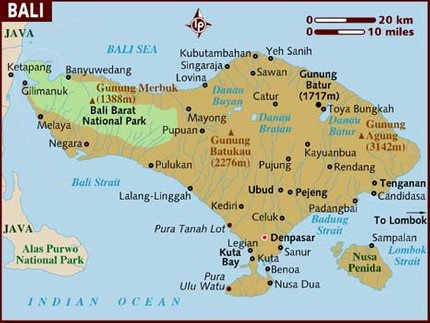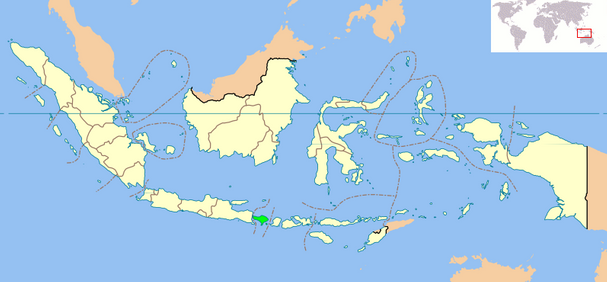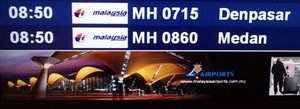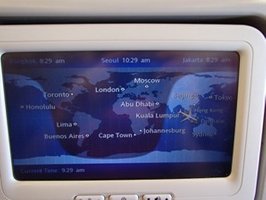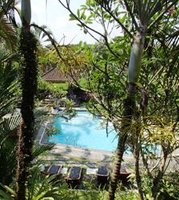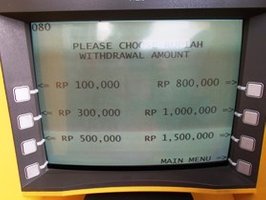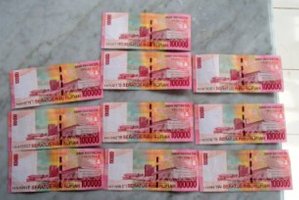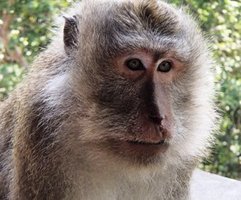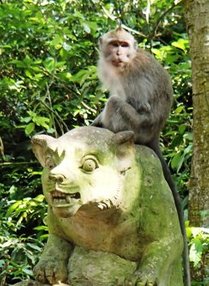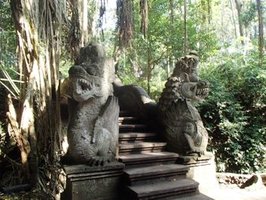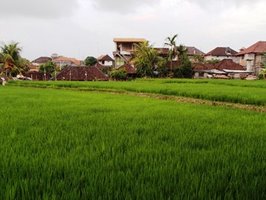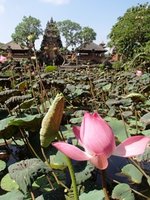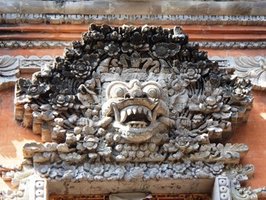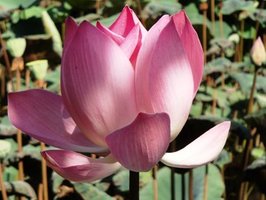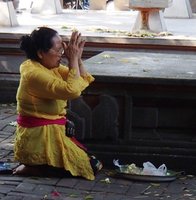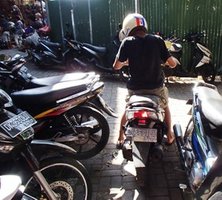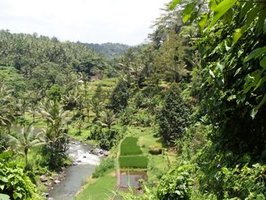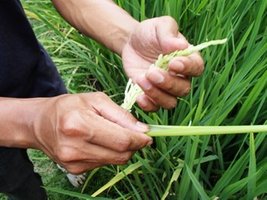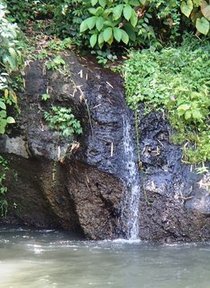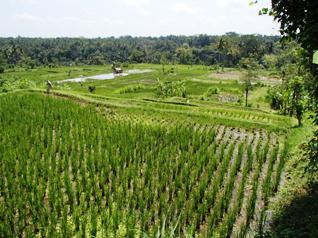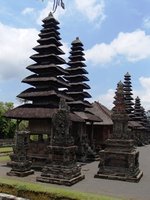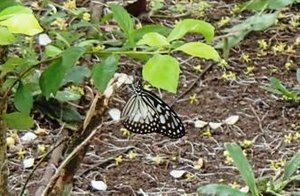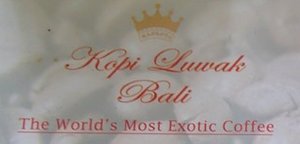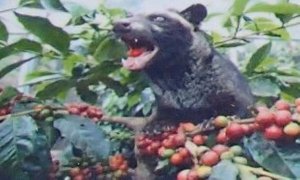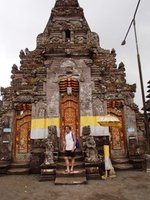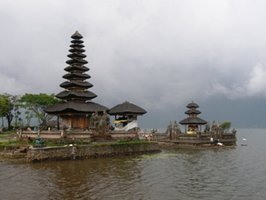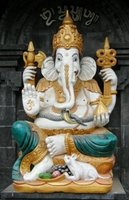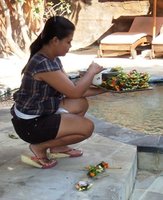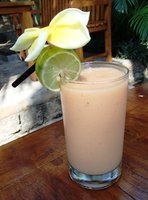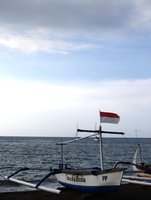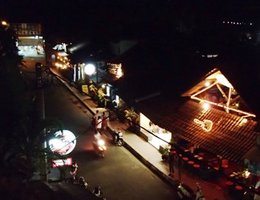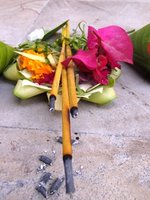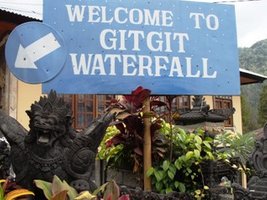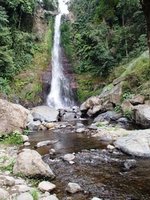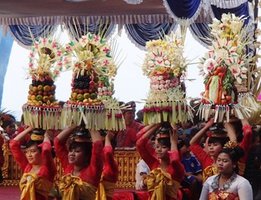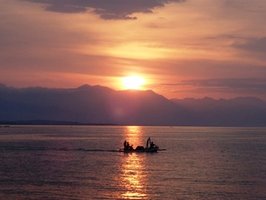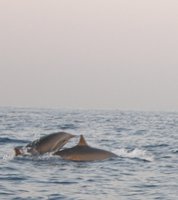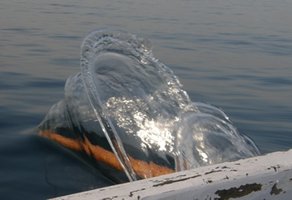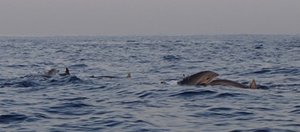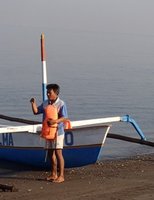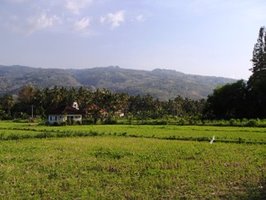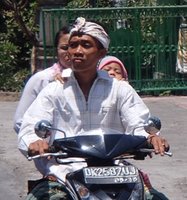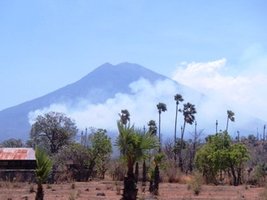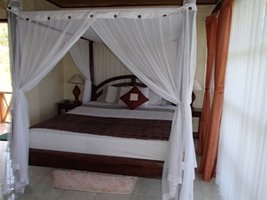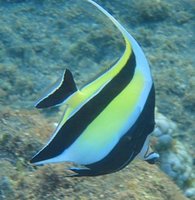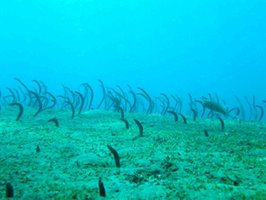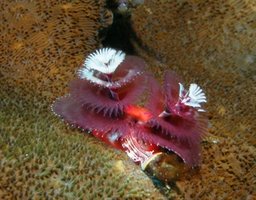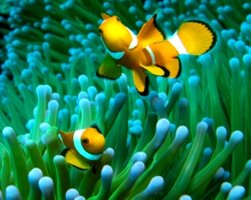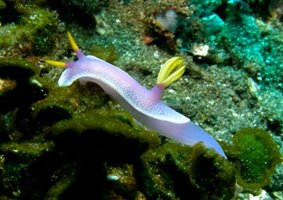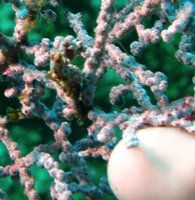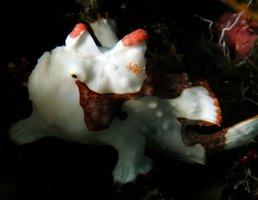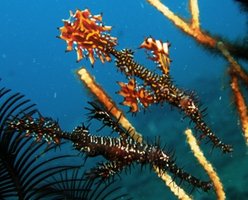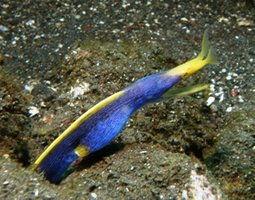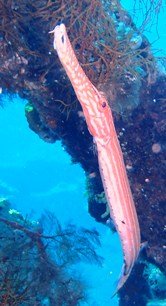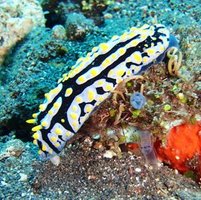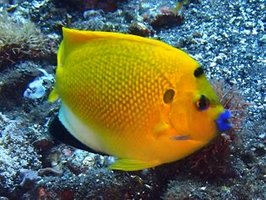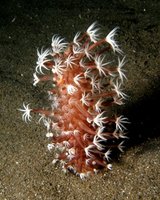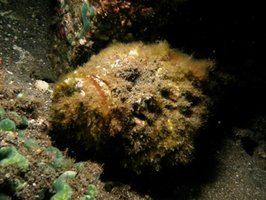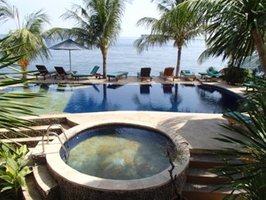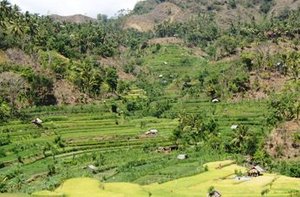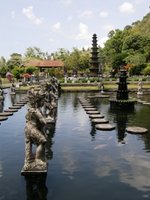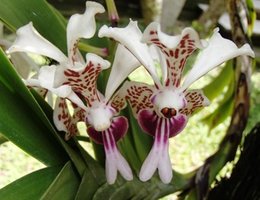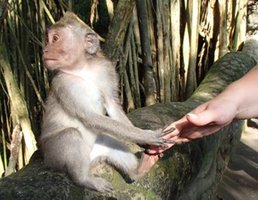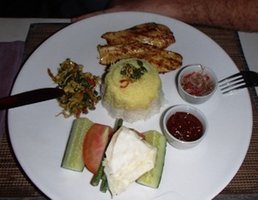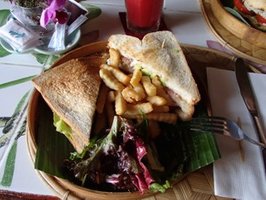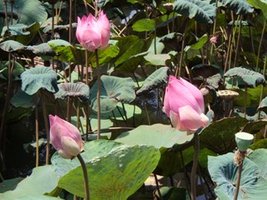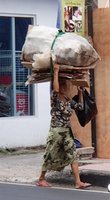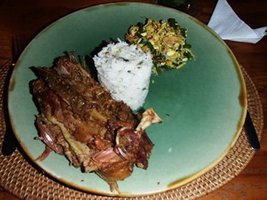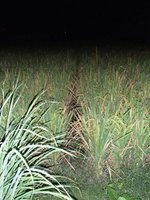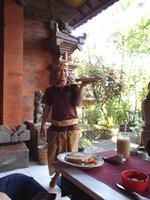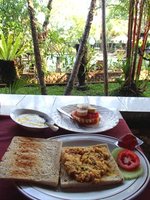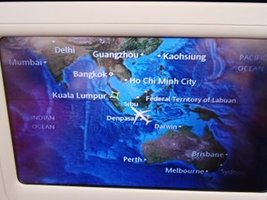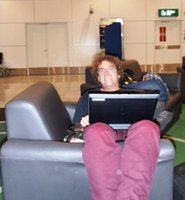ScubaTimo
Pagina over duiken en reizen in binnen- en buitenland
Website about scuba diving and traveling around the globe
Trip on the island of Bali
Ubud - Lovina - Amed - Ubud
From Saturday October 13th to Sunday October 28th, 2012
Dive, Stay and Relax in Amed Puri Wirata Dive Resort & Spa
Bali, Indonesia
Bali is a province in the country of Indonesia. The island is located in the westernmost end of the Lesser Sunda Islands, lying between Java to the west and Lombok to the east. It is one of the country's 33 provinces with the provincial capital at Denpasar towards the south of the island. The province covers a few small neighbouring islands as well as the isle of Bali.
With a population recorded as 3,891,428 in the 2010 census, the island is home to most of Indonesia's Hindu minority. In the 2000 census about 92.29% of Bali's population adhered to Balinese Hinduism while most of the remainder follow Islam. It is also the largest tourist destination in the country and is renowned for its highly developed arts, including traditional and modern dance, sculpture, painting, leather, metalworking, and music. Bali, a tourist haven for decades, has seen a further surge in tourist numbers in recent years.
Geography
The island of Bali lies 3.2 km (2 mi) east of Java, and is approximately 8 degrees south of the equator. Bali and Java are separated by the BaliStrait. East to west, the island is approximately 153 km (95 mi) wide and spans approximately 112 km (69 mi) north to south; its land area is 5,632 km².
Bali's central mountains include several peaks over 3,000 metres in elevation. The highest is MountAgung (3,031 m), known as the "mother mountain" which is an active volcano. Mountains range from centre to the eastern side, with MountAgung the easternmost peak. Bali's volcanic nature has contributed to its exceptional fertility and its tall mountain ranges provide the high rainfall that supports the highly productive agriculture sector. South of the mountains is a broad, steadily descending area where most of Bali's large rice crop is grown. The northern side of the mountains slopes more steeply to the sea and is the main coffee producing area of the island, along with rice, vegetables and cattle. The longest river, AyungRiver, flows approximately 75 km.
The island is surrounded by coral reefs. Beaches in the south tend to have white sand while those in the north and west have black sand. Bali has no major waterways, although the Ho River is navigable by small sampan boats. Black sand beaches between Pasut and Klatingdukuh are being developed for tourism, but apart from the seaside temple of Tanah Lot, they are not yet used for significant tourism.
The largest city is the provincial capital, Denpasar, near the southern coast. Its population is around 491,500 (2002). Bali's second-largest city is the old colonial capital, Singaraja, which is located on the north coast and is home to around 100,000 people. Other important cities include the beach resort, Kuta, which is practically part of Denpasar's urban area, and Ubud, situated at the north of Denpasar, is the island's cultural centre.
Three small islands lie to the immediate south east and all are administratively part of the Klungkung regency of Bali: Nusa Penida, Nusa Lembongan and Nusa Ceningan. These islands are separated from Bali by the BadungStrait.
To the east, the LombokStrait separates Bali from Lombok and marks the biogeographical division between the fauna of the Indomalayan ecozone and the distinctly different fauna of Australasia. The transition is known as the Wallace Line, named after Alfred Russel Wallace, who first proposed a transition zone between these two major biomes. When sea levels dropped during the Pleistocene ice age, Bali was connected to Java and Sumatra and to the mainland of Asia and shared the Asian fauna, but the deep water of the LombokStrait continued to keep Lombok and the Lesser Sunda archipelago isolated.
Tourism
The tourism industry is primarily focused in the south, while significant in the other parts of the island as well. The main tourist locations are the town of Kuta (with its beach), and its outer suburbs of Legian and Seminyak (which were once independent townships), the east coast town of Sanur (once the only tourist hub), in the center of the island Ubud, to the south of the Ngurah Rai International Airport, Jimbaran, and the newer development of Nusa Dua and Pecatu.
The American government lifted its travel warnings in 2008. The Australian government last issued an advice on Friday, 4 May 2012. The overall level of the advice was lowered to 'Exercise a high degree of caution'.
An offshoot of tourism is the growing real estate industry. Bali real estate has been rapidly developing in the main tourist areas of Kuta, Legian, Seminyak and Oberoi. Most recently, high-end 5 star projects are under development on the Bukit peninsula, on the south side of the island. Million dollar villas are being developed along the cliff sides of south Bali, commanding panoramic ocean views. Foreign and domestic (many Jakarta individuals and companies are fairly active) investment into other areas of the island also continues to grow. Land prices, despite the worldwide economic crisis, have remained stable.
In the last half of 2008, Indonesia's currency had dropped approximately 30% against the US dollar, providing many overseas visitors value for their currencies. Visitor arrivals for 2009 were forecast to drop 8% (which would be higher than 2007 levels), due to the worldwide economic crisis which has also affected the global tourist industry, but not due to any travel warnings.
Bali's tourism economy survived the terrorist bombings of 2002 and 2005, and the tourism industry has in fact slowly recovered and surpassed its pre-terrorist bombing levels; the longterm trend has been a steady increase of visitor arrivals. At 2010, Bali received 2.57 million foreign tourists. It is surpassed the target of 2.0–2.3 million tourists. The average occupancy of starred hotels achieved 65 percent (last year 60.8 percent), so still capable for accommodates tourists for next some years without any addition of new rooms/hotels, although at the peak season some of them are fully booked.
Bali received the BestIsland award from Travel and Leisure in 2010. The award was presented in the show "World's Best Awards 2010" in New York, on 21 July. Hotel Four Seasons Resort Bali at Jimbaran also received an award in the category of "World Best Hotel Spas in Asia 2010". The award was based on a survey of travel magazine Travel and Leisure readers between 15 December 2009 through 31 March 2010, and was judged on several criteria. Thermes Marins Bali, Ayana Resort and Spa, (formerly The Ritz-Carlton) got score 95.6 scored out of a maximum 100 of satisfaction index with spa facilities and services as No. 1 Spa in the world by Conde Naste's Traveller Magazine for 2010 by their readers poll. The island of Bali won because of its attractive surroundings (both mountain and coastal areas), diverse tourist attractions, excellent international and local restaurants, and the friendliness of the local people. According to BBC Travel released in 2011, Bali is one of the World's BestIslands, rank in second after Greece.
On August 2010, the film version of Eat, Pray, Love (EPL), which starred Julia Roberts, was released in theaters. The movie was based on Elizabeth Gilbert's best-selling memoir of the same name. It took place at Ubud and Padang-PadangBeach at Bali. The 2006 book, which spent 57 weeks at the No. 1 spot on the New York Times paperback nonfiction best-seller list, has already fueled a boom in EPL tourism in Ubud, the hill town and cultural and tourist center that was the focus of Gilbert's quest for balance through traditional spirituality and healing that leads to love. Newly launched packages by luxury resorts and spas like Ubud Hanging Gardens and the cliff-top Ayana promise to recreate Gilbert's four transformative months on Bali in a few passing days with yoga classes, drawn-out beach dinners, and massage therapy. Other tours built around the book focus on curative group gatherings and self-discovery of the kind Gilbert had. EPL helped boost Bali’s tourist numbers, together with the stable security situation on the island. Bali had 2.5 million visitors in 2010, exceeding their target of 2.3 million. That figure was also an improvement from 2009’s 2.2 million and 2008’s 1.96 million visitors. The Tourism Office admitted that they had done nothing to maximize the opportunity to promote Bali and surrender to the filmmakers to promote.
Since 2011, China has displaced Japan as the second-largest supplier of tourists to Bali, while Australia still tops the list. China tourists increased by 17 percent from last year due to the impact of ACFTA and new direct flights to Bali. In January 2012, Chinese tourists year on year (yoy) increased by 222.18 percent compared to January 2011, while Japanese tourists declined by 23.54 percent yoy.
Day 1 and 2: Saturday and Sunday October 13th and 14th, 2012: Departure to Schiphol and to Denpasar, Bali and further to Ubud our first stop
So we leave for a vacation of fourteen days. We leave to Bali, Indonesia and I could still book the flights so we could travel together. The main reason for this vacation was that Sarah wanted to celebrate her thirtieth birthday on a tropical island with a couple of friends. People, who know me a little, know immediately that I can’t say no to that. Who else is coming: Grete, Ward, Wendy, Sarah, Evy and me. When S decided to leave, I did not even know where the trip would lead us, but a tropical island in the middle of October; that’s always nice! Super! In the end the day comes: it’s Saturday October 13 and we needed this day to arrive soon. We had a bit of stress the last two weeks, not only at work, but also in personal life. Last week they broke into the car during lunch and stole the laptop and this week a blue van has hit into my car from the left. It happened on the Brussels ring road near the exit Strombeek. The Opel Astra is probably total loss, so that will be something we need to take care of when we’re back. We don’t care about it now, because we get up early at about six in the morning to pack some things and then take the car to Schiphol. We take the other car, because the Opel is somewhere in Machelen and we drive to Schiphol without any problems. I had made a reservation at the All-in Parking Zuid (South) and we arrive there after about two hours at eight thirty; a bit early, but still OK: it’s better to arrive early than late. We arrange payment, change of license plate, return date, because that was entered incorrectly during reservation and then we leave for the airport. Great!
We’re there after ten minutes and can check in at terminal three. We don’t have the possibility to already print the boarding pass, but need to queue at the check in desk. But everything goes fast, unbelievable. We hand over our luggage, ask to sit together and they can arrange that for the trip to Kuala Lumpur, Malaysia, but not for the last flight. We need to check it there. We’ll see. We make sure we have some cash, buy cigarettes and then have a smoke. Then it’s time to pass customs and at Schiphol airport they have something new. All European citizens can sue their electronic passport and immigration no longer needs to check the passports. Let’s try. This queue is a lot faster than the rest, so we arrive sooner at the tax-free zone. We did not have breakfast yet, so we take coffee, sandwich tuna and sandwich mozzarella and a croissant. We can use this food. We enjoy the breakfast and think it’s great we can leave together now. We check out the airport shops and look for our gate; we need to go to G9, have a check of the carry-on luggage and do a body scan. It’s funny to have it done, because the Netherlands is one of the first countries that have installed this. The previous times when I left from Schiphol this was not the case, but no it is. We wait a while for boarding time and quickly can board the aircraft. We’re seated together in the central row of five seats. It’s OK, but the seats at the windows would have been better. But we’re next to each other and for a flight of over eleven hours that’s nice. After priority boarding we can board and we hope we can leave on time.
And indeed at twelve they start the engines and we can leave for Kuala Lumpur: what a great feeling. Here we are for the next eleven hours, but after an hour already we get lunch. We eat and already more than an hour has passed. Time goes fast: only ten hours to go. We watch two movies and try to get some sleep. That is not working very well, because we only sleep for about two hours, every time just half an hour, but we can relax the first day or days, so we can gain some rest. The flight goes well and two hours before landing the crew starts to prepare breakfast. A minute ago we had lunch and now breakfast: that’s odd. We land in Malaysia and are six hours ahead of Belgian time. Nice! Most shops at the airport are closed, but we can have a drink and smoke a cigarette. But first we need to pass by the transfer desk to ensure we can sit together on the last flight too: seats 36 H and K, next to each other? Yep; they only skipped some letters of the alphabet and we even have window seats. We have a drink and then go to the gate C24. Quite some travellers are waiting already and it’s still one hour before departure. But again all goes well and we can leave on time for a flight of three more hours. We leave at 08:50 sharp and should arrive in Denpasar, Bali, Indonesia around noon. Great isn’t it? Then indeed the plain leaves on time for Bali. Here we come!
During the three hour flight we receive lunch to be able to adapt to the time at this part of the globe: scampi with rice and spicy sauce and beef with potatoes and vegetables. After a flight of more than eleven hours, a three hour flight is not long and we quickly descend to Bali. We cross Java and then the pilot starts the descent to Denpasar. It’s Sunday twelve o’clock noon and we’re at our destination. We’re really happy we made it without problems. The first thing we notice it the huge difference between the airport of Kuala Lumpur and the one here in Denpasar. Malaysia was really ultra-modern with smoking areas we haven’t seen in other airports, very modern. In Bali the atmosphere is completely different: very authentic and it looks very old. That’s the reason why many constructions are in progress. We already see temples in the typical style we’ll also see in Ubud and probably in the rest of Bali. It’s a huge difference, but each one has its charms. We buy two visas of twenty-five Dollars each and then we can pass immigration. That’s very smooth also and we can pick up our luggage later. We have both case and we can go outside after we’ve scanned the cases. No delays here either and then we come outside in the stifling heat and the Balinese fuss. There should be someone here to pick us up and take us to the hotel. Between about fifty people we need to find that one person. And indeed someone is waiting with a sign TIMOTHY and our flight number and also the arrival time on the sign. Great! He will take us to Hotel Oka Wati that we reserved for the first four days. Super! We take our luggage and two porters help us to the parking. Because we paid the visa in euro, we can already give them something and they decide themselves what they get. Normal? Yes. At first I had given them equivalent of a quarter of a Euro and even here that’s nothing. All is OK and then we can get into the car.
On the airport parking it’s busy like hell, unbelievable and then on the road (drive on the left side) it’s even worse. Total chaos, little scooters that pass left, right and every side, three cars next to each other on a two-lane-road and that kind of funny stuff. Road works in progress add dust and more noise to the equation: the first impression of Bali is totally the opposite of the tropical beaches you see on the pictures, but that will change. We drive through dirty roads with ancient buildings, really not your expectation of Bali. But we’re here and we’ll enjoy it for the next two weeks. It takes about an hour to get to Ubud. The driver stops at a football field and we walk the last part. It’s only sixty metres, so that’s all right. Compared to the centre it is an oasis of peace and quietness: a small open reception and we quickly check in. it’s unbelievable that everything went so well: from home to Schiphol, then to Malaysia, Bali and then the transport to the hotel: everything went perfectly without delay, really great. We get room 7B with a view on the pool and the garden and we think it’s lovely. We don’t unpack, but quickly change clothing, because it’s quite hot and humid. We enjoy the great weather on our terrace and then already dive into the pool. It washes off everything from our tired bodies and then we can explore the centre. We first ensure we have cash, can withdraw maximum 1.500.000 Indonesian Rupiah, about hundred and twenty Euro. We need some adaptation to these large amounts, but we manage quickly. We walk through the streets to explore the neighbourhood and check out the possibilities for dinner tonight. On every corner we see a temple or a sanctuary and many Balinese women arrive with offerings on their head. Loud noise from the traffic and the music and we grow crazy, so we enter a small street and have a drink. Then we look for a place to eat. It’s almost six when we’ve found something and order two mojito mango (happy hour) and have ribs and a fish sate. We like it a lot, but then we (especially me) get tired, so after dinner we have another mojito and then head back to our hotel. We enjoy the mood on our terrace with candle light and then go into bed. It starts raining, sometimes hard and sometimes softly ticking and that ensures we fall asleep without any problems. Have a great night. Our first day is already finished and we’re very happy to be here. When the first day already feels this good, what about the next ones. Reports about those will follow.
Day 3: Monday October 15th, 2012: Lazy Monday and Monkey Forest
We had a great long night with a couple of breaks mainly due to the heavy rain. But we don’t really care when it rains at night. It does not really rain, it pours, but when it’s humid during the day and it rains at night, we’re OK. I get up at about six local time and that means I’ve slept for about ten hours: great! Write the reports, use the Internet, but it does not work this morning. Apparently we need an access code this morning. After an hour my darling gets up and we enjoy the sounds of Ubud. In the morning we hear many different birds and there are many in the garden of the hotel, really great peace around us and we love it. A small heron has found its way from the rice field behind the hotel to the water of the swimming pool and parades on the premises: really marvellous. Right in front of us in one of the palm trees we see a lizard that is waiting for insects to pass by and then charges; a small sketch of the situation that early in the morning. Yesterday before we went to sleep we ordered breakfast: on our terrace they deliver everything at about eight thirty; omelette, scrambled eggs, fresh fruit juice, yoghurt with lemon and fresh fruits. Earlier that day I told that the fruit tastes much better than at home and that is correct: tropical fruit in a tropical environment; it’s a winner. We have breakfast and the hotel owner comes and says hi and apologises that they’ve served lemon with the yoghurt instead of honey: whatever, it tastes very well, so we enjoy and enjoy, like we’re going to do the whole day and the rest of the vacation.
We decide to make it a lazy Monday, so we lie down at the pool. The sun is shining and brings heat, but it’s very pleasant: the heat or the humidity is not bothering us. We can’t really cool down in the pool, because the water has almost the same temperature – to which extent temperature is important – as the air. We like it a lot and we’ve already said that a couple of times to each other. We rest at the pool and fall asleep for a moment. We feel we’re tired of the flights, but not that much. It’s normal we feel a bit tired. Before noon we take it easy, have a swim, rest and work our tan. That’s not very difficult here, because I’m a bit red already even in the shadow. We need to pay attention to the sun here, so close to the equator. I never use sun lotion and that will not cause any problems today. A great time here at the hotel, but we think it’s time to start exploring the village. We’re in a quiet street of the Monkey Forest Road, so the Monkey Forest can’t be far away. We check the Lonely Planet where we need to be and leave with our back pack to the forest. We only walk the road down for fifteen minutes along shops, banks, restaurants and we already see the forest. It can’t be more obvious, because there are two elderly ladies handing out bananas to feed the monkeys; when a tourist holds a banana in her hand and shows it to the monkey, she really is beyond herself, because the monkeys are used to people and they crawl on your arms, shoulders and stuff. They do everything to reach the banana.
They call upon us, because we need to pay an entrance fee: 20.000 IDR, 1.5 Euro, that’s not a lot. We still need to adapt to the amounts and the value of the money. Before you know it you’re on your way with a million of Rupiah and you only have eighty Euro on you. In Indonesia you can do something with eighty Euro, but there is a need to get adapted to that. We walk into the park and see large statues and of course many monkeys, otherwise it would not have been called the Monkey Forest, right? All paths join on a little square with a pond to provide water to the monkeys and from here one path goes to the main temple: PuraDalemAgungTemple. We look at the outside of the temple, because we’re not allowed in the temple. The view of the temple is quite nice: in the front there are three rows of statues and then a large wall and gate block the entrance: no access, only for prayer. We’re not here for prayer, so we’re not allowed inside. Also here it’s full of monkeys and we walk around the temple, see the square, but nothing special to see there. We should be able to walk inside, but it’s not allowed, so we don’t do that. Through the main square we choose a different path and pass along al the tourist shops, nothing to see here, so we continue to another temple, the one with a graveyard. There are about fifty stones that indicate a grave and we see the temple on the left side of the graveyard. Like with every temple there are many statues, but this one is much smaller than the other one: also nice for a visit, but not a lot to say about it. Everywhere we see he monkeys: there are even animals that are licking the temples stones. We see monkeys of all ages. Amongst baby monkeys there is an old one, who tries to maintain peace, but he does not succeed.
The last temple we need to see is the Holy bathing Temple. Long stairs lead us down towards a huge stone bride over a fast flowing river. Way down at the end of the bridge, indicated with snake heads, there is a third temple. All temples are Hindu temples. It’s nice to see the statues every time and I’ll try to find some more information about Hinduism. In general you can say there are three important elements for Balinese Hinduism, the Tri Hita Karana doctrine:
- Gods blessed life and created nature and all of its contents
- Nature offers sustenance to support the needs and activities of human beings
- Human beings have an obligation to establish a traditional village structure to build temples in which worship, to hold ceremonies, to make daily offering, to preserve nature and to solve problems together.
That’s it for now. We return to the exit of the park and need to stop for a great sight: a mother macaque has a baby on her belly and it looks like it has just been born. When there little they are so cute, unbelievable: next to me it touches the hart of a mother. It’s almost four in the afternoon and we have not yet had lunch, so we walk back up and stop at restaurant Sagittarius, which happens to be the constellation of E. There we have a snack: sandwich and salad, not a lot, but very nice, especially the spicy dressing on the salad. We don’t stay out here long and return to the hotel, where we have some rest: first swim in the pool and then rest a bit and check out what we can do tomorrow. We can’t plan a lot, but we want to do something and we need to check when S is here. Let’s see tomorrow.
At about eight we prepare for dinner, we walk the Monkey Forest Road and stop at Three Monkeys to eat with a view on the rice field. Next to each other there are three restaurants with that view and we try the one on the left first. It’s cosy that the lights create a romantic atmosphere and we can hear the typical sounds of a jungle. Within less than twenty metres from the busiest street of Ubud we enjoy the peace, just like at the hotel. We order a bottle of rosé wine from Bali. This is the only one brewed here, apart from a sparkling wine, so we need to taste it. It is great! We have lamb-lasagne and scampi with a salad and we love it. We still have some wine – nice excuse – so we also take dessert. Also this is very nice and we love this restaurant. We start our way back to the hotel at about ten o’clock and sit down on our terrace and totally enjoy the peace. If you can’t relax here and reach ZEN-hood, you’ll never be able to do that. We speak about the day and then go to bed. We haven’t done a lot today, but we had a great day. Sleep tight.
Day 4: Tuesday October 16th, 2012: A cultural day at Ubud
The morning is the same as the previous day. I get up at about six and my love stays in bed for fifteen minutes longer and then we can start enjoying a new beautiful day in Bali. First we surf the Internet in the free Wi-Fi at the hotel and then at about eight they bring our breakfast to the room: we think it’s great to start a sunny day this way. Probably it’s only getting better today. We start to wake up slowly and then consider different options. We prefer to quietly start the day and that means we start in the pool. We’re immediately awake and we enjoy the warm sun in the tropical garden of the hotel. It almost seems as if we get out of our room and enter a tropical rain forest. We have beautiful flowers in the garden; the birds are singing in the trees right in front of us and two lizards have found a good spot in a palm tree, waiting for passing insects. This is how we start our day. We swim a bit, rest to dry on the chairs. The sun comes through the clouds: it rained hard during the night. This way it’s really magnificent: during the day warm and sunny and in the night rain and a bit cooler: just super!
We’ve done nothing before lunch: swim, dry up, swim, dry up, read, until we text S. they’ve arrived here yesterday just before midnight, found a hotel and we’re going to meet them for lunch at about one. We’ll see them at the football field right in front of us. We make sure we’re on time and see four people walking over the field: one has an even paler skin than the other: that must be them. It’s nice to see S, W, G and W. Especially S has been a while since we’ve seen her: she’s in Asia for over a month now. We get all stories about Sumatra, Java and Malaysia during lunch at Sjaki’s. She had a great time thanks to the good care of the Indonesian people. We all prefer Indonesian food: Nasi Campur and Gado Gado. It’s nice and we support a local project for mentally handicapped people at the same time. That’s really a good catch. It’s great food and not expensive at all, although S can compare to the rest of Indonesia and she thinks it’s not so cheap. We eat for two Euro per person and the drinks are about the same. We discuss the plans for the next days and then we split.
They go to the Monkey Forest and we’re checking out some temples. We take the main street to UbudPalace and there we turn left to the Pura Taman Saraswati (Ubud Water Palace). The palace has a logical name, because in front there is a large pond filled up with lotus flowers. There is also a café called Café Lotus, also an easy one. The palace has been erected for the goddess Dewi Saraswati, the goddess of wisdom and art. The view is great with the large green leaves of the lotus and of course the flowers also. They’re pink, the flowers and the buds also; a great pictures with the temple in the back. There is one statement you need to consider before you enter: Entrance is forbidden to women during menstruation. I also read this in the Lonely Planet and there are also other moments when women are not allowed to enter the temples and palaces: during or right after pregnancy. This is not applicable and we also don’t enter the sanctuary. We mainly look at the beautiful water garden with the lotus flowers and the building at the end. It is very beautiful. We return to the street and check out the market place and another temple. This is a little temple, but seems to be very wanted with the Indonesian people, because the statues are loaded with offerings. Everywhere on and between the statues we see the small square banana leaf rafts with the typical offerings we’ve seen everywhere. There are so many here that we almost can’t see the statues anymore, until about five stories high. We like what we see. When we get there a woman is blessing some of her stuff and is praying. It’s nice to see what they exactly do. Regular life continues as normal around her with the noises and the smell of the scooters. They try to get everywhere with their scooters, even a small stretch where you have difficulty to turn with a bag on your back.
Right next to the sanctuary there is the market place: a hotchpotch of clothing, souvenirs, food; everything lies, stand, hangs at any place, and looks like a mess. Also the remains of the food is there and that causes an unpleasant smell. It stinks like hell. The market place is surrounded by several high buildings and one floor down compared to the street, so there is no fresh air. As you can think we don’t stay here very long and walk the road parallel to Monkey Forest Road until we reach the football field. We walk down the Jl Dewi Sita to check out what things there are to see there. We want to escape the busy traffic for a moment, but that doesn’t work in this street, so we enter the exhibition (in open air) of an art gallery. Here we hear nothing but singing birds, crickets chirruping and a waterfall falling down with the same noise all the time. A couple of metres away from the traffic we’re in an oasis of peace. We walk through the garden and watch the statues with more offerings: on every statue there is a banana-leaf with colourful flowers and often also with pieces of food. These offerings are really nice and you can’t miss them, because Ubud is full of these. We notice it’s already past four o’clock and we return to the hotel to enjoy the quietness and the swimming pool. In this heat it’s great to cool down in the pool and to float on the water. We enjoy every moment of it. S and the others are having a cocktail at Cinta’s and we relax on our terrace. We check on one the signs at the reception and ask which dances are worth a visit and where we need to be. They say we should go to Jl Dewi Sita and there the four are having diner. We join them and have a good red chicken curry and beef rending, also very tasteful. The Indonesian recipes are very good. We have a drink and then it’s time to move to watch the dancers and listen to the music.
We walk to the end of the street and there an old woman addresses us to sell tickets for “Barong & Keris”. This was not actually the play we wanted to see, but in the end it doesn’t really matter. It’s OK when we’ve seen a dance or play that makes Ubud famous. The show is at the Pura Kloncing at Jl Hanoman Padangtegal Kaja. It has just started when we come in and see the entre of the barong and a monkey that is doing strange things. According to the brochure this is only a small introduction, but there is no need to understand everything of the story – as they state themselves. It comes down to the battle between chaos and order. Too much chaos leads to total disintegration and too much order leads to stagnation. There is a need for a dynamical balance between both. Three dancers come on stage and this dance is very nice. It’s amazing what they can do with their hands and eyes: it’s almost not human. Every part is accompanied by music that brings you into trance. At both sides of stage (a large blanket on the floor) there are men with drums and different kinds of xylophones. A wooden base with iron plates that are keyed to different tones. There is one musician who only hits an iron tambourine: all the time, the same rhythm without changes and even without putting any different accent into the beats. This enhances the effect of the trance. The mood changes are done by all the others. In total there are about twenty people and it really has an effect on us. Some have bigger influence than others, because a Chinese lady has difficulties staying awake. In a strange way this is great music. They support all events on stage. The saga continues, but we don’t follow the full story, so we just look at the play they are performing here. Two strange creatures come on stage: one with a mask of a monster in white and long white hairs: thick, long threads of feathers, the other one the same in black. According to the brochure this is Durga and Kilika, who are playing the main part together with Kunti and Sahadewa, members of the royal family. The costumes are marvellous, both the ones of the demons and the ones of the princesses, really well made. At the end the balance is restored by the barong and that’s what it’s all about: creating harmony again by creating a balance between order and chaos. In total it takes about ninety minutes and then we return to the football field and we look for something to drink in this area. We really enjoyed the play, mostly the costumes, the dances and the music, because even with the brochure we did not catch the full story.
We drink a cocktail, most of us prefer a Lobong-cocktail: the local spirit, mixed with grenadine, sprite or something else. All cocktails are sweet and taste a bit like coconut, but they’re good and we have fun for a while there. We discuss the play and then continue our chat mainly about travels and cultures. Really nice. We stay here for about an hour and then we go to bed. We walk to the closest ATM, but this one does not work tonight: let’s try again tomorrow. We don’t have enough money on us to buy water and stuff, so we go to our room, relax a bit and then just before midnight we go to sleep for us this is the day when we stayed up the longest. Sweat dreams, Bali!
Day 5: Wednesday October 17th, 2012: A day of nature in Ubud: walk through the rice fields
Yesterday was late with the play and a drink afterwards, so we can use our sleep. It’s about eight when we wake up and I have difficulty to get out of bed, not really want to get out. I think this is familiar for all of you. At eight two people of the hotel bring breakfast to our terrace and we think it’s super again. If you did not get it: we enjoy every minute, every second we’re here. The sun is already higher than the days before, because we’re up late. We have breakfast with coffee and a mix juice of tropical fruits, really great, but the banana mix is better. After breakfast we notify S that we won’t do the walk together, because we prefer a romantic trip trough the rice fields. We prepare at about ten for one of the walks of the Lonely Planet. We need to take enough water: three litres should be OK; we can fill a plastic bottle at the reception. The water is not really cold, but many hotels offer this service to reduce the amount of plastic. If every tourist buys two bottles of water a day and throws them away, then the island is totally full of bottles by the end of the year and that can not be a good idea. So we help a bit and fill the bottle here.
The time says ten thirty and we’re on the road for a hike to Penestanan and Sayan. The walk is 6.5 kilometres and should take us about four hours. We’ll see what it is like. We start towards Ubud Palace at the corner of the street and there both walks continue. We want to do the shortest one, but that one will take the longest time. First we buy some cola and cookies, so we won’t become hungry and we already took enough water. We turn left at UbudPalace and here we can withdraw money from the ATM, not like yesterday. Everything that had to be done is done and we can leave. We walk the busy road and want to leave it, because it’s not really funny along this road. Our first stop is the CampuanBridge. It’s not an actual stop; just enjoy the view for a minute. A small river flows under tan iron bridge and at the left side there is an old wooden one and we take this. We don’t need to take any cars or scooters into account when crossing. Makes it a lot better. Just behind the Blanco Renaissance Museum we take a steep road up. This road takes us to the artist village of Penestanan. The road goes up and down and we see women at the side of the road with wood on their heads or they carry baskets with food. This part of the walk is already better than the busy road, because there is little traffic. In the shadow it’s OK, in the sun and uphill it’s nice and warm, even hot at times, because the sun burns. We stop a second outside of Penestanan at a school, where the kids are playing outside: apparently they also have a time to play here in Bali. The kids cross the street without watching the traffic and others encourage them to be cautious. Close to the school there is a temple that we check out, but it’s nothing special, but nice. We continue to the village of Sayan and there we look for the Sayan Terrace Hotel. A local tells us it’s a bit down the road and we locate it without problems.
We continue on the hotel grounds, pass a couple of bungalows and then the concrete path stops. From this point on the sandy path goes down very steep. We stop, think for a moment: is this going to work out OK, but my love is OK with it after just a few moments of doubt. Let’s go for it. The first guide does not give us a good feeling: he looks like a special type of guy. And then coincidentally another guide shows up and he tells us what he does and where we go and how much he asks. We like the idea to do this walk with a guide. I don’t even think about bargaining, so we probably paid too much. It doesn’t matter, because he’s helping us during the walk. We walk down the steep slope, but all goes well. On a certain spot a couple of steps are missing, so I jump the stretch down and lift her the same stretch. The guide thinks I’m crazy, but what the hell, everyone knows that already. We reach the river without problems and during the descent we already have a beautiful view on the Sungai Ayung: the river that flows down in the valley. We immediately notice that there are rice field at both sides of the river and the guide explains how they’re able to do that. They irrigate the land with water from the mountains and know exactly when they can harvest. On the right bank (our left side) they’ve already started the harvest for the second time this year. At our side the rice still needs to grow and we see the stews with the rice grains in it. We think the guide is a good idea: not only for extra explanation, but he also advices where to put our feet when we need to climb. And then suddenly we can’t continue, because there is a gate; a couple of farmers have fenced their property so hikers can not cross, unless they pay toll. We pay 55.000 IDR and can pass. It happens that tourists without a guide need to pay 50 to 80 thousand per person, which is a lot more expensive. The farmer lets us through and the path is well-maintained, so we think this is a busy path.
Our hike continues along the river and we love it a lot. The landscape is flat, so we don’t have any problems climbing or going down and we have some shadow and from time to time a cool wind in the valley. The guide takes us through tropical rain forest and rice fields: great! Above the water we regularly see hanging roots from the trees: they almost reach the water and a bit further we see a small waterfall coming down and flows into the river. It’s super here. Beautiful and colourful butterflies flutter over the fields: brown-orange, but also marvellous black and blue ones. It’s very difficult to take pictures, because of course they never just sit down. We also receive some more information about cotton-trees and papaya-trees and then a second time we need to pass a private property of a farmer. We pay the toll again and stop in the shadow to use some sun lotion. We’re close to a dam built by the Dutch in 1927. From this point the guide takes us to a wider part of the river where they also do rafting. The water is not very wild, but we think it’s a nice trip. We reach the bridge where we need to leave the river and return to civilization: the village of Kedewatan. This is where the rafting starts and here we need to climb stairs. We don’t count the steps, but there are many and in the heat at this time of the day, it’s pretty heavy. We reach a spot where we can enter the rive fields again and that’s what we do. This is easier to walk and a prettier view than the steps. Every other step people are trying to sell stuff: worth nothing and we don’t want to bring it along during the whole two weeks: so no shopping. This part in the rive fields is great. At the start the stems are very low and a bit further we see all stadia of the rice: just planted, a bit larger and also ready to harvest. We walk all the way to the end and rest in the shadow and look at the stunning view on the rice fields. On several terraces we see the rice and the tropical rain forest in the back, a great view, unbelievable. We stay here for about fifteen minutes and the guide calls a taksi (no typing error) and a bit later they take us to Ubud. It’s probably a friend of the guide, but that does not matter: ten minutes later we’re at the football field and we return to the hotel. We’re really pleased we did the walk, even though we were a bit tired, especially during the climbs and also due to the scorching heat.
Our next decision is a real no-brainer: have a swim in the pool and then check out what we’re doing tomorrow. We’re not OK to drive all the way to Pemuteran, so we take Lovina in the north of Bali. From there we should be able to do some excursions, so we’ll see. The pool is great after a walk and we relax. On our terrace we have a drink and a snack. It’s too late for lunch, so we limit ourselves to biscuits and a bit of potato chips. And again we love the peace, the weather and being together: GREAT! After the swim I go to the reception to arrange transport to Lovina. It will take about three hours with a couple of stops and I can reduce the price from 600.000 to 450.000 IDR. Not a bad deal. Tomorrow at eleven we’re leaving Ubud. We cool down in the pool a second time and then we get ready for dinner. A couple of days ago we ate at Three Monkeys close to the rice field and now we go to the same rice field, but choose a different restaurant: Rai Pasti’s. This looks more authentic and is a lot cheaper as well. We have Mie Goreng and Nasi Campur and are having a good time: the food is great. We take a cola and a beer. The local Bintang is OK, but the bottles are very large: 620 millimetres. We also have dessert, fruit salad with some ice cream and also that is very nice. Tropical fruit on a tropical island: yep, check! We get together with S, W, G and W to have a drink and have a mojito. This is more expensive that the food tonight. Two mojito are 130.000 and the food and drinks were 121.000, main course and dessert. This is amazing. We meet at Kafe Batan Waru and talk about our walks and what else is planned. We try to fit our schedules a bit and at ten thirty we return to the hotel, relax on our terrace and at midnight we go to bed. It was an exhausting day, but a real nice one. Hopefully more days like this will come, but we’re pretty sure they will. We fall asleep with the sounds of the rain forest.
Day 6: Thursday October 18th, October: Transfer to Lovina and three stops on the way
Today we leave Ubud and it’s time to say goodbye to Oka Wati Hotel and the good services they provided. They offer a great location, a very friendly reception and good service in general: nice rooms, superb garden and swimming pool, really great to stay here and escape from Belgium and the busy centre of Ubud. It’s great to stay here, a great town and a good start for a vacation in Bali. But today we leave here for our second stop on our tour. We arranged transport to Lovina yesterday and the driver is picking us up at about eleven. But first we have breakfast with a great view. The local squirrel is present again as he was every morning. He sits down in the palm tree close to us and it looks like he’s saying goodbye to us. The lizard is also waiting on his normal place to catch insects flying by. I’m trying to describe a bit the atmosphere in this small hotel; it’s great to stay here for a couple of days. After breakfast I write the reports, check out the pictures and E arranges the luggage. After about forty-five minutes we’re all done and we relax here a bit more. We’ve not booked a hotel, so we’re checking that out now. Wi-Fi is available again and we check bookings.com to see which hotels are available and how expensive they are for five nights. There is a hotel in Lovina at a busy road for only 191,97. We can’t leave this, so we make a reservation from today until the twenty third. Cool, everything has been set: transport, hotel. We can continue packing. The only thing left is the two bags and we’re done: great. Thanks, my love, to pack the two big cases.
It’s twenty past eleven and we take the luggage down the stairs. At least, I bring it one floor down and then the guys from the hotel take over. Very silly, because they would have taken it all the way too. We check out and pay 2.681.605,00 IDR, 219 Euro in total. After that they take our cases to the main street where the car is parked and then we leave to the north coast. Great: sitting at the beach is always nice. We leave for a trip of about five hours, two stops at temples included, alright, and then we’ve seen these as well. We start in the busy streets of Ubud, stop to fill up the car and then we can leave the centre. Through small roads we drive to the main road from south (Denpasar) to the north (Singaraja – Lion King). The road is somewhat wider, but still not a highway. We did not expect that. When we reach the main road, we stop for a visit to the first temple, the temple of Mengwi. Pura Taman Ayun is a temple close to the village of Mengwi west of Ubud. Taman Ayun literally means beautiful garden and that’s also what we see. The temple is devoted to the ancestors of the lords who ruled Mengwi until 1892. Pura Taman Ayun originates from 1634 and is in a water garden surrounded by moats with lotus flowers at three sides. You reach the temple through the main entrance (Kori Agung) with a status of Sai. We see several meru-towers that depict the mountains, the place of the gods. The highest meru (in the right back corner) has eleven levels and represents the mountain Gunung Batuka. The driver stops at the entrance, we pay 20.000 IDR for two people and enter through the main entrance. We walk to the temple and look at the towers, really very beautiful. We came here over a large inner square (jaba). At the right side there are many high towers, about ten and the last one is the largest, but also very nice. In-between and around there are stone ornaments and you can say they’re beautifully decorated. You can see the details with the heads tongue out of their mouth and also other tremendous decorations. Behind the temple there is a magnificent garden and also here we make a walk, because there is plenty of shadow and in the sun it’s hot, so we need water and sun lotion. Again many butterflies flutter between the trees, but it remains difficult to take pictures. The garden also has a spot for an artist that you really can call an Artist. Marvellous paintings of gods and also of the lotus flowers and the pond and canals. We agreed with the driver to stay here for about forty-five minutes and time really flies, because we almost need to turn back. We take the path through the garden, back to the entrance bridge, stop at a watch-tower, climb up and then return to the entrance. Only now we notice that some statues have also a face at the back side. We thought we saw that already during other visits, but then they were weathered by the elements.
After this visit we get back in the car and drive to the second temple: Pura Ulun Danu Bratan. That is supposed to be a trip of about one hour, but only after thirty minutes the driver already stops. As a coincidence this is at a tourist trap, although we’re going to like this experience. The stop is called “Coffee Break” and there is a picture of a kind of cat with coffee beans. Some will already know what this means. A Balinese of about seventeen welcomes us with open arms and gives us a tour through the plantation. It is a coffee plantation, but they also grow herbs here. She shows us several herbs and fruit and we can smell and taste them. The most remarkable are cacao, little mini-baby-pineapples and of course coffee plants and beans. It’s also nice to see how they roast the beans. An elderly lady is stirring the coffee in a wok: it’s quite funny to see how they do this and they still use the artisanal way. Next to the woman there are many herbs and we’re a bit surprised when we see the turmeric and the nutmeg, before they are grinded. Turmeric is like a root and the inside is beautiful orange. We’ve learnt something. Also about sambal we learn more: when you smell the leaves of the plant, you can already recognize the scent of sambal and you can easily grind it to spice up your food.
We stop at a table with about thirty jars of tea and coffee and a large amount of cups. This was to expect; we can try the coffee and the tea and especially the special coffee (robusta): Kopi Luwak. We get this cup first, need to pay 40.000 IDR for this one cup, about three Euro. We taste this one first and the rest of the coffees are nothing compared to this one. Really great, but pretty expensive. The coffee is made of beans and berries that have been eaten by the Asian Palm Civet. The girl assures us that we don’t need to worry about the pooh, because the beans have been washed for over three hours with warm water, dried in the sun and then roasted, so all remains of excrements should be gone by then. All in all it does not really matter, because the coffee is great. Apart from this one we also get different kinds of coffee: normal Balinese coffee, cacao, ginseng, mocha and vanilla. They also serve tea: hibiscus, lemongrass, ginger and a couple of other ones. In total we taste ten different kinds and the best one we drink completely: that is the Kopi Luwak. The guided walk takes to the furthest point of the plantation and there they’ve built a small shop where you can buy everything that you tasted? We buy three things: a pack of beans Kopi Luwak Arabica, a pack of lemongrass tea and a package of cacao-coffee and ginger: there will be some pleasant moments when we come back. It’s not cheap, but if you can bring this from Bali it will be cheaper than having it shipped to Belgium. We pay sixty Euro for all of this. On our way back to the parking we see the animal responsible for all of this, the civet: two babies and two adults in a cage. Then we have a last stop: a pepper plant. Not the peppercorns, but the spicy chilli pepper and this is supposed to be the spiciest one in Bali. I need to see this. I don’t see it, only the people around me see that it’s very spicy, because I quickly turn red. Not immediately though. The first small bite (the little end) is OK, but then it’s very spicy and I’ve only eaten a couple of millimetres of the pepper: unbelievable. We take one home and can have some people taste it; that’s going to be fun.
The driver then takes us to the north into the mountains. It gets cloudier and some raindrops are falling down. That’s not OK, because we still need to stop at a second temple today. On our way there we see some special way of transporting people. The first is still OK: twelve people in the back of a pickup truck and three in the front. The other one is a truck with an open container and about twenty people are standing up there. Add a bit of rain and wind, this becomes an ideal means of transportation. Luckily their car does not break down, although there are enough places to fix cars. The names are really nice: Knalpot (meaning muffler or exhaust in Dutch). There clearly still is an influence of the Dutch here: great! The road through the mountains is really magnificent. Behind every curve there is a beautiful panorama: the mountains, the terraces, the clouds around the volcano: magnificent. We ask the driver to stop and we can look over the valley and the mountains: it’s unbelievably beautiful to see this. Terraces of rice fields, of other crops and this in a mountainous landscape, as if we’re driving in the Alps, but it’s more oriental and there are no Alps, actually it’s only mountainous, but the rest does not matter; it’s beautiful.
Then we arrive at the temple of Pura Ulun Danu Bratan. The temple is on the bank of LakeBratan that plays an important role in the irrigation of the environment. It is located at an altitude of 1200 metres and it’s clearly much cooler here. As the first time the driver stops at the entrance and then looks for a parking spot. We pay the entrance fee (60.000 IDR), a bit more expensive than the other one, but still OK. The Lonely Planet still says 10.000 per person, but it looks outdated. In Bali everything is getting more expensive too. The temple is devoted to the goddess Dewi, goddess of water, lakes and rivers. It was built in 1633 and is divided over several islets in the lake. They eye catcher is the meru with eleven levels devoted to Shiva and his wife Parvati. Again this meru is great to look at. On the bank of the lake, on a small peninsula this tower was built and next to it a smaller one. They have magnificent ornaments and the lotus flowers in front of the tower add a pink and green accent. It’s great to walk along the lake and also the garden in front of the temple is nice. The central part of the temple is beautifully decorated. We’re not allowed inside, but between the iron bars of the gate you can see the gold and decorated rocks. Also the main gate is a nice piece of art. When we’ve seen every part of the temple, we go into the garden and see a stupa there. A stupa is a mound-like structure containing Buddhist relics, typically the ashes of deceased, used by Buddhists as a place of meditation. The term "reliquary" is sometimes used, after a Christian functional equivalent. Stupas are an ancient form of mandala. It’s a beautiful building. This way we reach the garden and there are many figures of animals and there are also directions how you need to take pictures for the best effect. We can’t resist doing this, but we don’t overdo it. We stay here again for about forty minutes and decide to return to the car and the driver to start the last part of the trip to Lovina. I quickly want a picture of a statue at the entrance of the parking lot: Ganesha, the god of knowledge and wisdom. Maybe it helps, because our brains and especially mine are switched off. Ganesha is the son of Shiva and Parvati and is usually depicted with a head of an elephant and a rat at his feet. There are several images of Ganesha, every time with different attributes. Usually it is a fat, nude belly, a pink-orange skin, a rat at his feet and of course the head. The rat that is stunningly little is his personal transport. Sometimes he has between the eyes (above the trunk) a symbol that resembles a “3”, the symbol of Om or Aum: the sound (vibration) from which the universe originates. Quickly I take a picture, so you can see what I mean in the photo album. Then we start the last hour of our trip. We pass a couple of waterfalls, Git Git for example, apparently a very beautiful one, but we keep it for later, because now we want to get to the hotel, check in and have a swim.
We continue higher into the mountains and there it starts to rain harder. The locals are prepared, because they all have a poncho on their scooter: you can tell who is a tourist, because they aren’t prepared. As quickly as the rain begins, so soon it’s finished too and everything is dry again. From here the road descends to a bigger road that connects Singaraja with Lovina and we should find our hotel on this road. We drive for fifteen minutes and we haven’t found the hotel yet, so the driver asks the way and we’re only two hundred metres away. E spots the hotel; we pass it and then turn back. He drops us off, we check in, pay him and then go to our room. We quickly throw everything in the room and relax on our terrace. Chox, a local diving instructor, is advertising for his business: Malibu Diving Centre. We get some general info about Lovina (comes from Indonesian Love – or he wants that we believe it) and then it’s time for a swim. Here we don’t hear the busy traffic of the road in front. You still hear a distant noise of the scooters and cars, but that’s it. We relax and look for a restaurant to eat. We walk to the beach and see the sun set above the sea and the mountains. It’s very nice, but not super, because there are many clouds. Maybe it’s better tomorrow. We stroll along the beach to a restaurant where we have food and rinks. We also notice that there is a festival here during the weekend and we’re going to check it out and maybe do some other things too. We’ll see, but first we dine at Tropis Bar and Restaurant: fried calamari and fried mix seafood. As we’re used to, it’s very good with some rice, cola and a Bintang. It’s getting late when we leave here and take the other side than we came here. The distance is longer and also a long stretch next to the busy road, but after fifteen minutes we’re back at the hotel. We enjoy the peace on the terrace and each other and then we go into bed and immediately fall asleep. The bed feels great after such a long day: visit temples, being in the car a long time, but with great memories we can quickly fall asleep.
Day 7: Friday October 19th, 2012: After lazy Monday, today is lazy Friday
We’re again awake early on this beautiful Friday morning. The sun shines through the windows and wakes us up at about seven. We get up and it’s already hot with a shining sun. Hmm, what else do we need? We slept well, no problem with the busy road here and we can do a lot of things today. As the title already says, that won’t be the case today. After two long and tiring days we start a lazy day today. We start the day with a breakfast in the garden of the hotel: it’s a good breakfast. We get two eggs how you want them prepared. We order an omelette today, ask a bit of bacon with it, drink Balinese coffee and a mix fruit juice. We also get some bread: toast, normal bread and a bit of marmalade and chocolate paste. It’s a great moment in the tranquillity of the hotel garden. The table is only a couple of metres away from our room and we sit between palm trees and other tropical plants they’ve planted here.
The garden is beautifully planted: in the centre of town, busy traffic from all sides and you almost don’t hear the noise. In other words: we’re at a great place again. And great is even an understatement. When we’re having breakfast, they are placing the offerings at the pool and on different locations in the hotel, especially on the walkways, so you need to watch where you put your feet when walking there. Now we see how they do it. Someone is creating the packages and another person puts them on the ground with burning incense sticks. At the same time they use a brown fluid for blessing. Maybe we should ask what it actually is. We enjoy our breakfast and then relax at the pool. The pool here is pretty small, but they can accept only twenty-four guests at a time, because there are only twelve rooms. They never are at the pool at the same time. We relax, write the reports of the day before and I look using the Wi-Fi for some more information about the temples, the gods and Hinduism and Buddhism in general. It’s fun to look for this info. After an hour we swim a bit and then dry up, write some more or read The Chronicles of Narnia. It’s not really a punishment to start the day this way.
The owner of the hotel, Susan, a Dutch woman, says hello and asks if everything is alright. Yes, it certainly is. Everything OK. She has bought the hotel from a Balinese owner and it was not good then, old, ancient ruin. She has restored it and now it looks good. She kept the stile, but there is more luxury and comfort according to our standards. It’s great. The rooms are spacious, clean, well-maintained and especially the bathroom: almost the same as home. There’s a large shower, a wall next to it and then the toilet. Two large sinks and everything is very clean and everything is perfect. The hotel is very good and has great deals when staying a couple of days. Also the garden and the pool are nice: a lot of green with palm trees and other exotic plants. Like I said: a great hotel to stay a couple of days. They even have a spa here and we think of using it, but that will be tomorrow. Each room of the twelve has a separate terrace or balcony and is pretty private, so also that’s nice. We dive a couple of times into the water, let us dry, read, write and at about one in the afternoon we think it’s time to go into town. We walk to the busy road, then take a smaller street and walk to the beach. We had already done this yesterday, but now we look for a place to lunch. We find a nice place at Sea breeze. Right on the beach and we have a fresh fruit juice: orange and papaya. Sometimes they add water to the juices, but these are so thick and the colour is so beautiful, we’re certain they’re not adding any water here. At the same time normal life continues: a man in long trousers, a warm sweater, a woollen hat is cleaning the beach, another guy is building the footpath and we’re enjoying the cool breeze on the terrace: that has caused them to choose this name probably.
We order two rolls and a hamburger: a large meal for lunch and pretty heavy, so we’ll keep it to something lighter tonight. After a meal of not even 100.000 IDR we follow the path to the west. There we walk to the surf to walk with our feet in the water. It’s pretty warm: we think it’s over twenty five degrees. A disadvantage is the huge amount of waste on the beach, but apparently they will have a beach cleanup this weekend. A part of the festival is about cleaning the beach and that needs to happen here. A lot of plastic, T-shirts, but also natural waste: every metre we see the leftovers of the offerings that have reached the beach in one way or the other. The shore is full of dead coral and we don’t like that either, but we can think that diving here will be OK with this amount of coral. We’ll see that when we reach Amed. First we stay here for a couple of days and enjoy every moment we have here. We forgot some stuff at the hotel, so we go back, take everything, clean our feet, because the black volcanic sand is sticking to your toes and feet. That’s nice on the beach, but not for visiting a restaurant. We come back to the beach the other way and stop at Malibu Diving Centre, where Chox said we should go to for excursions. When we get there it almost look as if the guy at the centre does not even know him, although he says he’ll call him and send him to our hotel. He will be there in vain, because we’re going to drink a cocktail.
At the restaurant where we ate yesterday we drink piña colada and a margarita and look at the sunset. There are less clouds than yesterday, but still not good enough to have a beautiful sunset. We have a couple or days more here, so we’ll be alright. We sit here for about an hour, talk about the vacation until now, the past days and also about the stressful days before the vacation, but we’ve almost forgotten about those. We spend some time before having a snack by looking for postal cards to send home. We pick eighteen cards and will send nine: who knows when we’ll be able to write them and even when they will arrive in Belgium, if they ever do. A card is 1500 IDR, so about 0.120094 Euro, the stamps are a lot more expensive: 10.000 IDR, so 0.800626 at the current exchange rate. In total the cards cost a large amount of money, but not really high in value. We consider the possibility to eat at the hotel, but decide to go into town. The hotel is expensive and noisy along the busy road. We pass two restaurants, look at the menu, but that does not look good, so we move on. At restaurant Papagallo, a pizza place, we find a very extensive menu and also different kinds of pasta, so we have enough choices and we enter there. We take two stairs up and will dine with a great view. We see the lights in the mountains, the neon lights of the cafés and restaurants and we enjoy a good drink and a nice meal. We have plenty of water and a cuba libre that seems to be a cubba libber rather than cuba libre, but it’s good and with a lot of alcohol. We’ve found a nice place again. We have spaghetti bolognese and napolitana and we like them a lot. When you’re on vacation, everything tastes better. We don’t pay a lot either here: 138.000 IDR and return to the hotel, because it’s getting late.
There is a small queue at the store where we buy water and cold drinks and then we relax on our terrace where we watch the starry night. The moon shines through the palm trees and the stars sparkle in the black distance. It’s a great sight and a good end to a glorious relaxing day. We’ve also already made a tentative planning for the next days, but Monday is still unsure: we’ll see what happens. We can leave here a day early, but it’s also possible that we’re going to snorkel in the west of the island. But for now: we close our eyes and go to sleep.
Day 8: Saturday October 20th, 2012: Git Git Waterfall and Lovina Festival
The title says it all, but before we do anything, we take it easy before lunch time. We have breakfast in the garden as the previous days and have a sunny-side-up, toast, very good bread, coffee, fruit juice mix. At the same time the sun is shining through the palm tree leaves and a light breeze gives coolness. We enjoy every moment, it’s great to wake up like this. Just like we do, the Balinese have their morning rituals. One is climbing a palm tree and is throwing coconuts down; a lady is preparing the offerings and another lady is putting it on the ground and at the Buddha statues. A guy follows in her footsteps ten minutes later and puts more offerings on the same places. You can see these little pieces of art play an important role in the religious life of the people here. We first relax, write the report, have a swim and work our tan. Like I said: we feel great here. We can use these relaxing moments and hopefully we can these back home with us. We’ve received confirmation from the hotel in Amed that we can arrive one day earlier, so we need to see how we can arrange that here. We’ll see. At about eleven o’clock we’ve been at the pool long enough and think it’s time for some action: not too much action, because there is not a lot left on our planning here.
At the reception I ask one of the people how much it would be to go to Git Git: that is a large waterfall and that was one of the things we certainly wanted to see when we booked our ticket to Bali. Today we want to go there and a guy at the reception calls someone to arrange transport for us. On the phone I try to bargain a good price. The suggestion at the reception was 400.000 IDR, but that is way too much. We don’t want the driver for the rest of the day; it’s already noon, so maximum 250.000. I even succeed in getting 50.000 less, so we pay 250.000 for transport there and back. The driver picks us up at the hotel, will take us to Git Git, will wait for us there and take us back to the hotel. What a luxury: great! The driver introduces himself as Eka and he calls us Stimo and Eva: well, not easy these names for Balinese people. Quite funny! Through the busy traffic Eka drives to Singaraja, takes a small road, navigates left and right and after twenty minutes we ready the parking lot of the waterfalls: we’ve had some great views on the rice fields and the mountains on our way there. On the Internet and in the Lonely Planet they warned us for a difficult walk, so we start a bit frightened: our muscles still feel the walk in Ubud, so hopefully it will be OK. We walk the stairs down and it’s only five hundred metres to the falls. It’s OK, because there are only stairs and not a muddy path or something similar. It’s not busy either, because it’s los season. We only see a dozen people and we think it’s not a lot for a tourist attraction this size. On the whole stretch women are selling sarongs, masks, incense sticks, but we don’t react to them. Some things are pretty, but they should remain in Bali and don’t fit into a Belgian living interior. We have a couple of picture-stop on the way: a river with an office to pay the entrance ticket (5.000 IDR each), a great view on a rice field and a couple of times to look at the view onto the mountains. Pets are walking freely: ducks, dogs, chicken, but not the roosters they are kept in cages and can’t do any harm. When they would be running free, they would cause a great deal of trouble. We think they’re also using them for cock-fights. Don’t want to think about that.
With the stops we reach the waterfall after a walk of thirty minutes. And it’s very quiet there: we had expected a crowd, but there are only like ten people. I ask a French lady to take picture of us and she manages very well: not bad at all. The waterfall is very pretty: about fifty metres high and we fancy a swim, but we don’t have our swimming gear on us. Let’s then just look at the water plunging into the deep and the mountains around the fall. The swallows fly on and off looking for insects, butterflies are fluttering and some land on the black sand to use the salt. At the left side of the waterfall we see a statue with sarongs and with offerings on and around it. Beautiful. We stay a while after the rest of the tourists have left and we have the valley for ourselves. We enjoy it a bit longer and then walk back. We had been thinking of having lunch here, but there is nothing that seems OK, so we go back to the car and our driver. On our way back we see a small sanctuary decorated with sarongs (black and white, light orange) and some statues have a hat on top. Hopefully they can resist the heat easily. But no worries, because the water of the fall will cool them down. We could stay here for a longer time just to look at the water and the valley and the mountains. The entrance to the waterfall and for us now the exit, is through a temple-gate. It’s only a small one of three metres high, but it’s beautifully cut and decorated. From here you can still see the waterfall and that is a great view. We pass the shops again and also the ticket-checking-office. The guy who needs to check the tickets is almost sleeping. Once you’ll find the best job of your life. With views on the rice fields, the woods and Lovina in the distance we reach the parking again. We’ve been here for about an hour, but it was splendid and worth a visit. A nice image is how a cat and a chicken can be friends here in Bali. We also see a swastika on the wall of a house. Luckily it has a different meaning here than in Europe.
Eka, our driver is waiting for us and takes us back to the hotel. We ask him whether he does transport to Amed also and we negotiate the price. For a private transport he starts at 500.000 IDR, but that’s too much. We tell him we only paid like 350.000 for transport from Ubud to Lovina: a little lie. Eventually we agree on the 350 and we just need to call him from the reception when we leave Monday or Tuesday. It will probably be Monday. We take a shower and get ready to go into town. The festival will start at five and we’re on time to see the arrival of the dignitary. We’re standing behind the beautiful chairs with the locals and also Eka is here with his son. Nice! Everybody watches the start of the parade. Different groups from the area are executing dances, from marching-girls to young guys with drums and cymbals. They’re dressed in special clothes, which is typical for these festivals. They’re dressed very pretty: not only the dresses are beautiful, but also the hats. A couple of women have towers of fruit and flowers on their head: in total they’re almost a metre high, a marvellous sight. We are stunned that they can carry all of this on their head. And then we notice the sun starts to set, a bit west of us over the mountains. We move away from the crowd and walk to the large monument on the central square and there we can easily follow the sun. It’s very romantic and a very beautiful sunset this evening. She’s slowly disappearing after the mountains and leaving a beautiful red glow on the clouds and the sea. The parade of musicians and dancers also passes here, so we can look at both at the same time. Great, isn’t it?
It becomes busier, because the whole village and the neighbouring villages have come to join the festival. Add to that the many tourists and it is becoming very busy. Of course we take a couple of nice pictures of the setting sun and then we’ve had enough. This afternoon we booked a trip to the dolphins at the hotel and we need to get up at five tomorrow morning. We have supper early than the days before and go to the same restaurant as yesterday. A romantic table for two in a corner on the second floor and we love it a lot. We have spaghetti carbonara and Thai chicken with rive, but get fries. Doesn’t matter. We drink a lot of water, but first a cocktail: tequila sunrise and banana daiquiri, both of them are delicious. A dessert at the end: fruit salad with vanilla ice-cream and a banana pancake with chocolate ice-cream. This is almost the most expensive we’ve had here in Bali: almost 300.000 IDR, unbelievably expensive J. Then we return to the hotel, relax a bit and then we go to bed early and have some sleep. Tomorrow we need to get up early, so we can use a good night. Tomorrow we’re going to say hi to the dolphins! Super!
Day 9: Sunday October 21st, 2012: Dolphin watching
Five AM: we hear a knock on the door. Hello, good morning, I’m the captain of the dolphins. In half an hour I come again! Well, that’s half an hour earlier than expected. Susan had told us we would leave at six, but it is a bit earlier then: at five thirty the captain is there again and we need to come to the reception. No problem, because we’re ready. He leaves to the centre and we walk with two other couples to the main square with the dolphin statue; the sun starts to rise and shines on the dolphin, the mountains and the sea. The sea is very calm this morning, almost a mirror. Superb! We continue a bit where all the boats are and we get in: one captain for each boat and maximum four tourists per boat. And it’s surprisingly calm here. Susan had told us that it’s very busy, because everyone leaves early and there is a huge crowd who wants to see the dolphins up close. The captain puts the boat into the water with the help of another person and then we can climb in. the boat is very nice. It’s very narrow: we all sit one behind the other and we just fit in. At both sides there are two floating devices, because without them the boat would quickly tip over and sink. So then we leave with a couple of other boats from the beach. While the locals are cleaning the beach after the festivities yesterday, we head out to open sea. We already see shadows of other boats in the distance. On our right side we see the sun rising and a fog is forming above the palm trees along the shore. Just to see this it’s already worth getting up that early. And we still need to see the dolphins: super. We don’t see a couple of boats, rather about twenty. We come closer and the closer we come we see more boats. Also the Lonely Planet had said that this was a spectacle on its own. When we’re close enough, we think there must be like seventy boats in about hundred square metres. It’s only an estimation, because it can be more or less. It comes down to the fact that there are many boats and in each one there are two or four person, so there must be hundred people coming here to watch these mammals. You could ask yourself whether the animals like this. We see a couple of fins on the surface and at once twenty boats race to the scene. The animals dive away, so they don’t seem to like it that much. It’s almost a race to see as much dolphins as possible and to come as fast as possible to the dolphins.
Our captain joins the race a couple of times, but then stays behind. And that looks like a great plan. He is watching the jumping anchovy and also a small tuna, he hopes the dolphins will be doing the same, because they need to eat. At first it does not help a lot, but then we see about eight fins ten metres away. Race towards it and we closely see the dolphins coming up and going back down. One is only surfacing with a fin, but the other one comes out of the water completely. A great sight and the day has started marvellous. We repeat this scenario a couple of times and we see one dolphin perform caprioles and leaps out of the water with the body straight. Great to see with the rising sun. These visits of the tourists here could be harming the animals, but they won’t mind a lot, because they return here every day. They would not be here if they did not like it. It looks like there are more people and boats than dolphins. In total we see about a dozen times the dolphins surfacing and each time they’re in a small group of about five animals. A nice image is to see about eight fins and backs rise above the surface, all at the same time and in the same direction: really magnificent. We stay with the dolphins for about an hour and then return to the beach. We arrive there after twenty minutes and we then walk back to the hotel to have breakfast. The day has started early, but it’s a magnificent way to start a day this way. We like the breakfast and have it close to the kitchen. That easier for the waiters and we are already used to the noise of the traffic. It will be a warm day today, we already notice that now. After breakfast we take it easy, write the report, have a swim, and work our tan. Others at the pool are directly in the sun and they’ll get another colour: red. We relax on the sun beds in the shadow and we prefer that, because otherwise we’ll get sunburnt. We dry up and then get back in the pool: we are enjoying every second. We make this a very relaxing vacation.
At about lunchtime we go to the room: there is a bit cooler and we recover from the heat. Then we go into town, because we want to have lunch. We have lunch at Tropis Bar where we already were earlier; it’s actually right next to the other restaurant, but has the same name. I want to try the gado gado, but tofu is not my taste. The rest of the dish is great, even the satay sauce. A Gordon blue with mushroom cream sauce is very nice too with a bit of rice and fries and we’re ready for the afternoon. We walk on the beach and return to the hotel. We won’t be doing a lot today, because we’re tired and have a bad day: that’s also related to the heat today, it’s unbelievable how hot it is. Between three and four we think today has been lazy enough and we have a stroll around Lovina. We take the busy road to the west and follow it until we want to leave the busy traffic and can turn into a smaller road. Here we arrive in the real Bali where the people live have their garden and we don’t see any tourists here. We check things out. The small houses are pretty dirty, but they all have an orchard with jack fruit and banana trees, but that’s all. You wouldn’t expect anything else when you get off the beaten track. We walk down the road for about hundred metres and then the road gets more difficult and we return to the main road and then to the beach. We continue to the Bar Sea Breeze. It seems a good idea to have a drink and that’s what we do: fresh orange juice and a large Bintang. We love it of course. We think we’re on a good spot, have some salted nuts with it (literally: nuts with salt) ad garlic bread and then the sun starts to set. The sun sets in a beautiful way today. We see the large orange-yellow ball of the sun disappear behind the mountains and it throws out a red-orange glow over the sea and the clouds. Yesterday we saw a great sunset, this morning a beautiful sunrise and now a gorgeous sunset again. It’s great to be here.
From here we continue to the beach, return to the hotel and stop to buy sprite and water for our trip tomorrow. We leave everything in the fridge in the room and then look for a good restaurant. Tonight we go to Kakatua. We order two delicious meals: fresh fish in lemon sauce and dices of fresh fish grilled in banana leaves. They taste unbelievably well. The restaurant is a bit more expensive than we’re used to, but the food is great: we think it’s even the best we’ve ever eaten here. One dish is fish with paprika, peppers, tomatoes and onion, the other one is fish with lemon sauce and onion, but the taste of lemon does not predominate, is only slightly present. After that delicious dish we also take dessert: chocolate cake. At about ten we return to the hotel. We’re awake since five o’clock this morning, so we start to get tired. We stay a while on our terrace and then hit the sack. Day nine has ended, but we still have some to go in Amed. Sweat dreams!
Day 10: Monday October 22nd, 2012: Transport to Amed and exploration
We are in Lovina for the last moments today. First we arrange everything here at the hotel, so we can call Eka en leave to Amed where I’m going to dive for a couple of days. I’m really looking forward to that. But first a nice breakfast here: two time sunny side up, chocolate paste, strawberry marmalade and a bit cheese. Add to that some coffee and a mixed fruit juice: a day can start worse than this. Then we sit on our terrace, pack, write the report of yesterday. Time flies, because day ten has already started; that’s less good news, but we still enjoy every moment here. We’re ready at about ten and hand back the towels at the reception. The MasterCard terminal is down, so this is not good, except when the manager passes by, then everything works fine again, but we need to pay three percent extra as for every transaction. Everything is OK and Eka is already there to take us to Amed. Great isn’t it? We already agreed on a price, so there is nothing left here. The case in the car and on the road to Amed. Nice! The first part is pretty busy from Lovina to Singaraja and there we pass the centre of the second busiest city of Bali, so traffic is a mess. Everywhere police officers are directing traffic and scooters are racing between cars. We even pass a Carrefour, so Bali is similar to Europe when it comes to this. Only the parking lot is totally different than Belgium. At home we would see a parking lot full of cars and maybe a few bicycles or scooters, here it’s the other way around: full of scooters, really full and just one or two cars. It’s a funny sight.
Once we’re outside of Singaraja, traffic is less and we follow the coast to Amed. We don’t stop, but look outside to the landscape. The land is dryer, the rice fields disappear and make room for forests, banana trees and magnificent hills. The road along the coast leads us up and down. Eka has a totally different driving style than the previous driver: he drives like crazy and fast, sometimes he’s held by a truck or a bunch of scooters, but we’re moving OK. At the end of the trip we see volcanoes, really magnificent mountains and we think it’s a great view at our right side: the sea is at the other side. The drive to Amed is great, relaxing in the back of the car and Eka drops us off at the hotel Puri Wirata. First we see another hotel with the same name in Tulamben, but we continue to Amed and read the village easily. We continue outside the village and from here it’s another six kilometres to the hotel: on such a small road it takes longer than on a highway, but a highway is not available in this part of Bali. We start thinking quite soon that there is nothing here: we see one lonely restaurant, a small shop, but nothing else. And then we don’t see a single thing for the next ten minutes and Eka turns towards the hotel. It looks like there is nothing else than diving here. We did see some diving centres here though: they are built one next to the other, but that’s not everything we wanted. We wanted to buy some souvenirs before we left Bali the last day or days, but that will not work here.
With a special feeling we arrive at the hotel, great location on the slope of a hill and we check in. they take us to our room, number 28 and the room is magnificent: a four-poster bed, nice bathroom with beautiful shower and a large terrace with e great view on the ocean. They’ve given us a very nice room. But our feelings are not OK, because apart from diving there is nothing we can do here and that’s not nice. With a bit of a bad feeling we go for lunch: we have a sandwich chicken. And it’s very expensive here too. Not good to end our vacation here. I ask some more information to the waiter: the nearest ATM is forty five minutes away, a supermarket is at forty minutes, so we’re really in the middle of nowhere. After lunch we discuss what to do and we quickly decide we will not stay here for five days. I arrange we can go back to Ubud, there are rooms available at the same hotel and I also arrange a driver. Then we feel a bit better and we can explore the surrounding area. There is not a lot to explore though: about hundred metres there is a small shop where we can use our last cash to buy some groceries and we can go to arrange the dives. They’ve already put me on the planning for tomorrow for three dives and maybe a nightdive and we receive a perfect explanation from Tom, a Belgian guy, nice to meet a Flemish guy here. Everything is settled then, dive tomorrow and the day after: I need to be at the centre at eight. And that’s only on the entrance of the hotel, which is very nice.
To pass the rest of the afternoon, we borrow a snorkel and mask at the diving centre and go snorkelling n front of the hotel. For my love this is the first time and we’re bit curious how this will be. We put our bag on the concrete in front of the hotel and enter the water. At the beginning everything is black, the rocks and the sand, but a bit further I see fish. First I had given a short introduction how to use the mask and snorkel and we’ve tried the mask under water, see how she manages to breather through a pipe like this and then we can start. Everything goes well and we see plenty of small fish. The usual butterfly fish hang above the coral or what’s left of it and we enjoy every moment. There is a bit of current, so we’re very careful. The instructor had warned us for the current, so we’re alright. A parrotfish passes us and the small blue-yellow fish find shelter between the rocks. A pufferfish is also around and we both like it a lot. For me this is no surprise, but she likes it too: the first time she goes out snorkelling. And then on a location like this, marvellous. At the end I see a nudibranch only half a metre deep, so that’s a good end: not really a very colourful one, but nice with black and green colours. Really very nice!
Then we return to our room, have a shower and eat at the restaurant. I call S to explain we won’t be staying here for five days and she understands the reasons why. We had planned to celebrate her birthday here, but that won’t work, hopefully we meet in Amed. She thinks it’s a pity, but doesn’t want that we don’t have fun our last days here and is OK with whatever we decide. We had expected that, but it’s nice she has said it and means it. Then the food: mie goreng ayam and seafood with cola and Bintang. We have a good afternoon and evening with the snorkelling and supper. At about ten we return to the room, enjoy the great view of the starry night and then go to sleep. Tomorrow I’ll be diving, so that will be great.
Day 11: Tuesday October 23rd, 2012: Diving day 1: Around Amed
Already a bit before six we’re awake in this magnificent room with a marvellous view on the ocean. On our right side in the east we see the sun rising between the palm trees and we like it a lot. We already saw the rising sun in Lovina, but this is even prettier. We stay here on our large balcony and enjoy the view. If you want to describe a great advantage of this hotel it certainly is the view and the room, just great. We almost seem to forget we’re in the middle of nowhere. While I write the report of yesterday, my love is staring at the sea and asks: what kind of animal is that? No idea, because I haven’t seen it. A bit later two dark brown fish come to the surface and blow water from their back. That must be dolphins or whales: let’s ask Tom later. At about seven thirty they serve breakfast and we’re checking out what they have today: coffee as much as you want, eggs the way you want it, so we choose sunny side up and mixed omelette. We also have a fruit salad and a freshly made watermelon juice and we’re ready for our day. The whales apparently are pilot whales, large dolphins: it seemed bigger, but we’ve spotted whales already today. Then it’s time to say goodbye, because at quarter past eight I need to be at the diving centre: both camera’s, fill out the forms and try on the equipment. We’re all ready to leave, don’t take anything that should remain dry and they drop us at the next bay. Here we enter the water for a driftdive and we should arrive at the hotel. We get ready: the guide, two Swiss ladies and me. The other group consists of one instructor and two American ladies. At the place where we enter the water we see Balinese women cleaning fish: in about ten crates we see snappers and other species of fish that are waiting to be transported to hotels and other places.
Then we can start. The first part is very shallow and the current is against us, but it’s not heavy, which is nice. We won’t reach the hotel this way though, but that will soon change. I see a lionfish, really a beautiful animal. The nice blue-yellow fish we already saw during snorkelling are here in great numbers and when we leave the coral, we arrive at an eelgarden. And this is quite a garden. Hundreds of eels stick their bodies out of the sand and disappear when we approach. It’s a great view: that many eels together is great. I succeed in getting close enough to an eel to take a picture just before he disappears in the sand. Then we reach a part where it becomes deeper. From here it goes down a couple of hundred metres, so we need to be careful that we don’t go too deep. In the beginning we reach almost thirty metres. The visibility and the view are impressive. Sponges are very large: almost the size of a human being. The surgeonfish swim around us in large numbers and we continue our dive. At this depth there is more current and it goes with us now. We loose control a bit, because the water is pulling us away. We have little control over the speed of our drift, so it’s a fast dive to the hotel. The guide will say later that there is more current than usual. A small selection of the things we see: Moorish idol, emperor, nudibranch (to be identified), many butterfly fish and also different species, really great. We see anemone fish too and as during every dive they are so cute. Feather stars have found roots on the sponges and the corals; it’s magnificent what we see under water. And then the instructor signals he has spotted a shark. About ten metres away from us we see a shark of one and a half metre in the current and he seems much better adapted to the circumstances than we are. Nice! A shark during my first dive here. A bit later we see two large barracuda’s and continue our dive.
Due to the heavy current and me fighting against it, I use a bit more air as usual and in addition this is the first dive after one month, so air consumption is higher. The guide shows us two large stingrays, not the blue-spotted, but with light dots at the end of the tail: another species I haven’t seen yet. We’re on our way for half an hour and this is already a great dive. I suddenly see a large nudibranch, about ten centimetres, I try to call someone, but nobody is close enough. Black stripes over the back of the slug and they form islands of white and yellow dots. It looks like one I’ve already seen, but not this size. And then there is a problem with the regulator. That’s not so good, it stagnates at seventy bars already. I have a look around: where is the rest, because I need to find someone as soon as possible. The two Swiss ladies are too far away and the instructor is about ten metres apart. I can still breathe, but not very well, so I start swimming to the guide, in three or four strokes I am with him, signal him that I’m out of air and take his second regulator. That’s strange because I’m still over fifty bars. I have a heavy breath a couple of times due to the effort and a bit of stress and I join the instructor to the surface. We have our safety stop and surface. I’m no longer interested in the fish or other creatures; the main focus is to get up safely. We manage that and on the surface I can still put air in my BCD, we return to the beach and to the hotel. All right! This was a great, magnificent dive to start with, only unfortunate that I had this little problem. They need to service it and give me another one.
I take a quick shower and I’m happy I can spend an hour at the pool with my love here. She stayed at the hotel and has been swimming and reading in a chair. When she’s reading time flies, so now too: the first dive is already finished. We’re happy that we can be together for an hour, but time flies when we’re together. One hour is gone just like that and I’m already preparing to go to the diving centre: we now drive to another bay to dive the Japanese shipwreck. They load everything into the van and twenty minutes later Balinese women take the gear on their head to the beach. Easy and it’s impressive they can carry that much weight on their head. We see a buoy ten metres from the beach and the guides tell us that the wreck is there. That’s close! We prepare everything and can enter the water. From the shore we already see the pieces of wreckage. They are overgrown with soft coral, but often it’s damaged by divers and snorkelers. The fish look for shelter in and around the wreck and because it’s so shallow it is a magnificent play of sun, wreck, water and fish: it’s a good suggestion to dive here. The wreck is not a big one, because after fifteen metres we’re diving the wall. The wreck as a wreck is not special, because there is not a lot left, but the reef is more beautiful. We see scorpionfish on the sand, large sea fans are rocking on the current, hard coral, soft coral: we see everything here. A couple of parrotfish eat the coral and the butterflyfish are here too. And then the first nudibranch of this dive and there will be more. The first one is white and brown with brown ‘ears’ and very pretty. The next two are blue and then a black one with blue accents. This is a great location to spot nudibranchs and I like it a lot. A large anemone offers shelter to a couple of anemone fish and we continue along the wall. It’s a great dive with plenty of colours: blue sea squirts and others are black and yellow. And then there are also the many fish with different shapes and colours, swimming between the coral and the divers. A Christmas tree worm is located on the coral and provides me with a feeling of familiarity because it’s always present in tropical water. Two more nudibranchs pass by and then anemone fish in a blue and green anemone. Superb!
We’re almost half way so we turn back: for the record, I still have hundred and twenty bars, so the air consumption is much better: there is little to no current here. Then I see another species of nudibranch: this one is black with green dots. And right after a purple one with white accents and yellow tentacles. The sponges are outstanding, especially because they’re so big, actually they’re huge. A bit shallower we see three scorpion leaf fish, also nice to see this one. And then the guide swims towards a sea fan and I hope, I hope. YES, he has spotted a pygmy seahorse. He has seen it, but I haven’t yet. I look in the proximity of his finger and then suddenly see the well camouflaged seahorse between the branches of the coral. Only two centimetres, but oh so cute. YES, YES, YES! Is it clear I like this a lot? Yes, certainly! I take pictures and hope that I will have a couple of good ones. Then we return towards the wreck and hang out there. We’ve almost been under water for an hour and it only seems like a few seconds. I’m really very pleased with this dive. We can have a shower with the gear and then take the van back to the hotel. We can’t arrange a third dive today, so I go back to the pool and enjoy the dun, have lunch and then back to the pool. With a view like this, it’s great to be here. It’s a pity that I can’t dive a third time, but number three will be available tomorrow. We have spaghetti and chicken sandwich and then relax. After an hour we return to the room, but all the stuff there and at about four we go snorkelling again. We use the equipment of the diving centre and get into the water on the same place as yesterday. There is a lot more current today and higher waves, so it’s a bit more difficult, but we’re alright. We don’t see anything special, nothing more than yesterday, but we’re having fun during these thirty minutes. Then we take a shower and prepare for supper. We have pizza and a fish curry and we love it. Since we’re both tired we want to go to bed early: first use the Internet, check e-mails and then into bed. We fall asleep at about ten thirty. Tomorrow I have diving day two and then hopefully three more dives. We’ll see!
Day 12: Wednesday October 24th, 2012: Dive day 2: Tulamben: USS Liberty, Coral garden and nightdive
Same drill for waking up as before. Write the report on a beautiful balcony with view on the ocean and the sunrise. Super! Then a nice breakfast at the restaurant and two hours after we got up, our paths split. First we go to the diving centre together: all the gear is read to dive at Tulamben for two dives there. I get in the van and my love goes to the supermarket and then relaxes at the pool until I’m back. After half an hour we arrive there and during the transfer we have a great view on the volcanoes here along the coast. We already saw them when we came to Amed and now I see them all the time. It’s great to see that these mountains are so close to the sea and rise so high from the ground. We arrive in a small hotel with the second centre of Bali Reef Divers. It’s great to be here, it’s close to a busy road, but all dive locations are within walking distance, so that’s nice. Also the Liberty? Yes, also the wreck of the Liberty. My guide Gede has a short briefing about the wreck and then we prepare everything. They will take it to the dive spot by scooter, there we put the tank on our back and get into the water. On our way there I speak to Gede about diving, the wreck and what things I can expect. Yesterday the other guide, Kadek, told me that a pygmy seahorse was also living here. Hopefully we get to see this too. We’ll see.
We cross the street, cross a busy parking lot where they sell T-shirts of the Liberty – I’m not going to buy one – and five minutes later we’re at the beach of the Liberty. It was an American transport vessel that was torpedoed by a Japanese submarine in January 1942. The ship was built as a cargo-vessel for animals and served in the Second World War. In 1963 an eruption of the MountAgung has moved the wreck from the beach to about thirty metres from the shore. The volcanic stones and sand now ensures this is a very popular diving spot in Tulamben and there is supposed to be many coral and fish here. In the water we make the last preparations, put our fins on, wear the mask and then Gede will guide me to the wreck. I’m curious what it will be like. He points some small nudibranchs to be, really tiny ones, but also a couple of big specimens. He asked me what kind of things I wanted to see and he takes that into account, just like all the guides here: a really great service. I want to see it all, but especially macro and then this wreck is the right place. The first ten minutes we see like ten nudibranchs and we haven’t reached the wreck yet. Jesus, what will this be here? A couple of things will be totally new to me and the first thing is already there: a praying mantis lobster. Inside the layer under a rock you can see the animal: beautiful eyes and the two arms folded under the head, a very pretty sight. And then the animal shows its full appearance: you can clearly see this is a lobster and the most remarkable is the green-blue tail: really great colours. After that we see the wreck: a large wreck, broken into three pieces. The under water life is very abundant here: bass, butterflyfish, snappers and several other species, magnificent. Hard and soft corals grow on the wreck. Small damselfish hide in the hard corals. Just as I already saw in Egypt they disappear into the corals when you come closer. I love this spectacle a lot. There are two types of sea squirts here, the same ones as I saw yesterday. These are just details, but they’re very nice. We continue our dive along the wreck and meet more butterflyfish: longnose butterflyfish, phantom bannerfish and s couple more.
We’ve passed the first part of the wreck and dive between the remains of what used to be a majestic vessel. And then Gede shows a small white fish between the plants: a giant frogfish, the white version. It’s only a small fish to be called giant, but it’s lovely to look at. It is white with red-purple spots and has similarities with a clown. I could stay here for hours to look at the animal. But we need to continue and see a species of flabellina (nudibranch): white, purple and red, beautiful. Right next to it two nudibranchs are turning around and they seem to be in love: this will result in small nudibranchs! Then Gede stops at a piece of hard coral and takes his pointer to indicate a small crab of a couple of centimetres. It’s a brown crab with hairy legs: an orang-utan crab, named after the monkey and you can clearly see the resemblance. Also this is a great dive until now. Yet another species I’ve never seen before. Well, I don’t see it myself first, but the guide does. Close to hard coral where also feather stars are living, two harlequin ghost pipefish are hanging around. I am so happy that I’ve seen these and that I also have a couple of pictures. But we’re already on our way back and dive shallower. At the deepest place we were hitting thirty metres again. There is not a lot of current and very relaxed diving and I’m happy with this dive. And then the second pygmy seahorse of this vacation is seen. This time it’s the brown version and is sitting beautifully on coral. It’s so cute. You can easily recognize the shape, better than yesterday with the purple one. The rest of the dive there is nothing special anymore. I mean of course no new species for me, because it’s almost an aquarium here when you dive. Normal anemone fish and Clarks anemone fish are here too, so nothing special is more like an understatement. By the end of the dive we go even shallower and we see a huge green humphead parrotfish, a royal angelfish and an emperor angelfish. During the safety stop I still enjoy the view of the small blue fish against the black sand and after about an hour we stop the dive.
We return on foot without the gear, because that is being taken care of for us, to the hotel and dive centre. We stay there for about an hour and I have a chat with Tom and an Australian couple that is here with their son and then I already get the briefing for the second dive. This will be CoralGarden and hopefully this will be as much fun as the first dive today. Via a small path with plenty of garbage we walk to the dive site. We arrive on an enchanting beach with palm trees and a lazy Balinese guy (maybe this is pleonastic) and here we need to dive? Harder punishments exist than this. The first thing we see is a small scorpionfish, a large yellow-white-black nudibranch and a large school of snappers and butterflyfish. A good start. We spot an anemone with the nosestripe anemone fish, really cute these guys. Gede shows a couple of small crabs: so small, I’m very surprised he can even spot them: one is perfectly adapted to live in red corals and the other one is hiding in the side of a large sponge. I think it’s great how these guys can spot those little crabs. There was a shark here this morning, but we don’t see it now, it’s OK, cause there is enough to see. After a couple of nudibranchs, I see something special: this time not a slug, but a flatworm with several colours, very nice. The dive is very shallow, because we don’t reach deeper depth than fourteen metres. There is little to no current, so everything goes quietly. A yellow three spot angelfish, completely yellow with black eyes and a black dot above the eyes and then a blue mouth: the cute fish swims along. And yet another animal I’ve never seen before. A light blue body with a bright yellow head sticks out of the black sand. The body and the head regularly come out of the sand and you quickly recognize a ribbon eel. This was one of the things I wanted to see: check! I enjoy every second of the dive just like the one earlier today. The first one was more impressive thanks to the wreck and the abundance of fish. There is less coral here, but plenty of fish, also a very nice dive. I try to watch everything and also at the anemones and fish and some of the anemones are partially closed. That has a nice effect. We see a couple of hawkfish and then it is getting too crowded, so we look for another place. I look at a goby living together with a yellow shrimp and it’s nice to see how they’re working together. The shrimp is blind, but keeps the layer clean and at the same time the goby watches the area. This is a good collaboration. Close to the remains of an old wreck there is a lot of fish: snappers, small damselfish, glassfish and bigeyes. It’s amazing how this all looks like and I’m very pleased with these two dives today. After an hour we’re done, but I still have a nightdive for today. We clean the gear and take it back to hotel Puri Wirata where I’m very happy to see my love again. We’ve send texts a couple of times between the dives and we’ve missed each other only a couple of hours.
At one thirty the van arrives back at the diving centre, I go down to the swimming pool and then we have lunch. We have a chicken sandwich and a club sandwich. We drink enough water and then we relax. A dive into the pool and then dry in the shadow. I tell my story of the last two dives and we’re both happy that they were good. We relax some more, work our tan and enjoy the peace and each other. Time flies, because it’s already three o’clock, so we’re still together until about sixe when I leave for the nightdive. We discuss our relationship and our future and the fact that we will make everybody jealous when we’re back, because our time here is passing fast now. That’s not so funny, but we already had a great time and we’re still having a couple of great days. We talk, relax, enjoy every moment and dive into the pool/ as always when we’re together, time flies and also now that’s the case. It is five soon and it’s time to return to our room, prepare the camera’s for the dive and enjoy each others company. We also check out the pictures of the first dives and we’re both impressed what was already captured. There are a couple of great pictures. Five to six, quickly check e-mail to see my mom has sent a message and then ready to dive. Everything is ready and we drive to Jemeluk for the nightdive. About ten minutes in the van and we arrive at a beautiful bay, really amazing with still the red glow of the setting sun. Here is the nightdive tonight. Kadek, the same guide as yesterday hands me a torch and we enter the water. Once the sun has completely set behind the mountains, it goes quickly and darkness enters at a great speed. Start! First thing we immediately see is a cuttlefish, super. Second is a mimic octopus, again super.
A good start of the dive. We swim over the sand and there are many feathers in the sand. They look like long straight sticks with everywhere small tentacles that are filtering the water. Some of them even look like small trees. And then we see anemone-like thing, suddenly rising from the ground. It’s very big. Kadek shows a nudibranch below a rock: first we think it’s a Spanish dancer, but it’s not, a dark-brown species, almost aubergine: then we know this is a species of pleurobranchus, the same as the last nightdive in Egypt in July. She’s as beautiful as a Spanish dancer, but a bit hidden between the rocks. Tonight we spot a whole bunch of cleaner shrimps and also some coral banded shrimps. At a certain moment the shrimp is next to a crab, both with the back to each other, a nice view. During the night the lionfish are swimming freely and we see different kinds: one more beautiful than the other. A small moray eel with a white head is seeking shelter below the same rocks as the shrimps. The eyes of the hinge beak shrimps are lighting dots on the reef. The reef itself is a bit damaged, because there are also crown-of-thorn starfish and there is a lot of broken coral here. Or maybe this is due to the divers. No clue.
The first torch Kadek gave me broke down, but after a small adaptation it worked again, but now the other one is down, but he solves both problems, so I only have a couple minutes of total darkness. A pufferfish appears from the blackness and says hi: yellow at the bottom and grey at the top, a cute animal. He even swims against the side of my hand: good evening pufferfish. The side of the small fish was very soft, nice encounter. During the nightdive we often see sea urchins and today that’s no different: toxic leather, fire and other sea urchins. We slowly start our way back, because we’ve been diving for about forty minutes already. We see some more nudibranchs and a long flatworm. Dark-blue with a white edge and two feelers at the front: otherwise you would not be able to tell front from back. On the broken shells a special type of anemone lives, at least I think it’s an anemone: a short stem as a basis like a small tree and at the end jelly-like tentacles: it’s something very special. They don’t like lights, because they pull back the tentacles when we come closer with the torches. A few moments before we reach the sand again, a scorpionfish is resting on the ground, again a beautiful animal. And then I see a strange creature: the basis of a feather star with long tiny branches, with very fine ends. When the ends have filtered something from the water, they bring it down and the food is being swallowed. Also this animal reacts to the light. From the guide of the Indian Ocean of Debelius I find that it’s a Medusa Head. First time I see this. You can only see these during a nightdive. And then Kadek points out a stonefish: yes, great: it’s still one of the most poisonous fish in the world, so be careful, but don’t worry as long as you don’t touch it. We usually never touch things under water, except when a pufferfish swim against you. The last thing we see is an anemone that is the home of an adult and a smaller crab. At first I thought the small crab was being eaten by the anemone, but after I spotted the bigger one, I realised that it was some kind of symbiosis. Of course it was not the last thing we saw, because a kind of stargazer is right next to it and all the time the small luminescent are swimming above the sand. But then the dive ends and after an hour we get out. We quickly dry and return to the hotel.
At the hotel my love is waiting and we still need to decide whether we’ll stop by Sarah or not. They are not very close, so it is difficult to arrange transport there. We’re both very tired, so we send a text to S and tell her we’re very sorry we won’t pass by today. We’ll see each other back in Belgium. Then we have supper: nasi goreng and squids in lemon sauce. The food at the hotel is great. At about eleven we are too tired and go to bed. Tomorrow we move back to Ubud to stay two days in the peaceful village and hotel. We’ll have some stops on our way, but you’ll read all about it.
Day 13: Thursday October 25th, 2012: Departure from Amed, back to Ubud: Water Palace and Monkey Forest
Today we leave Amed and return to Ubud. We had decided this, because we’re too far away from everything; we can’t buy any souvenirs and are almost obliged to stay at the hotel. We did not want that, so we have arranged transport and a hotel in Ubud. It’s a pity that we miss the birthday of Sarah, but we talked to her and she’s sorry, but understands our decision. The reason to go to Amed were the dives and they were really great, maybe a pity I only did five, but the five I did were mind-blowing thanks to Bali Reef Divers. They have arranged it very well. Tom and Birger have made the diving centre from scratch to what it is now and they have three locations: one at the hotel Puri Wirata in Amed, the second at the same hotel in Tulamben and then the third also in Tulamben close to a budget hotel. I was at the last location yesterday. The service is super: you have a lot of input on the dive sites and the guides also look for things you are interested in. especially for me as a nudibranch-lover and macro photographer this is interesting. Macro photography rules here in the east of Bali. The guiding is almost private, because I did one dive with two Swiss ladies and the rest was a private guided dive. Great! Also the nightdive was nice: in many diving centres that would have cancelled the dive, when there is only one diver, but not here: here they do the dive and they have a great focus on customer satisfaction. It was very nice. The rental equipment is also nice; there was the one problem with the regulator, but apart from that everything was in good condition, BCD well serviced, suits are good and printed with Bali Reef Divers or Puri Wirata, so they thought of everything. Tom and Birger: you’re doing a good job and keep up the good work!
We have breakfast at the hotel, go online, because there is free Wi-Fi, call Malaysia Airlines to confirm the flights, everything is OK, so we will be able to go home. We enjoy breakfast and show a couple of pictures of the nightdive. An American woman was there at the first dives and was curious what you can see here at night. We check out and pay a bit over 300 Euro. For five dives, three nights, all the food we think this is still not too bad. Bali is very nice for a traveller’s budget, even if you stay at luxurious hotels like this one. We take some more pictures to make everybody jealous with the view we had here and then we see our driver to Ubud is already there. He takes the car one level up so we don’t have to drag our luggage to the car. We don’t need to do it ourselves, but then again. We close our bags and then put everything in the car to Ubud. We look at the different restaurants and hotels in Amed to see if we spot S, but that’s not happening today. We stop for a beautiful view on the bay of Jemeluk with all the special boats and we like it. We continue through the narrow streets of Amed, need to wait a couple of times, because there is opposing traffic and sometimes the road is totally blocked. Scooters have no issues with it, they continue without problems, but the cars need to wait for the garbage truck for example this morning. We take the road along the shore, but quickly need to ascend into the mountains. The view is again stunning: rice fields against the slopes of the mountains, beautifully green and a view up to the ocean: magnificent. We had requested one stop and we already have two, but the most important one still needs to come.
After a drive of forty five minutes through the mountains we arrive at Taman Tirta Gangga: the WaterPalace. The rajah of Amlapura, a village close by, was a huge fan of water and has built his dream palace which became Tirta Gangga. Entrance fee is 10.000 IDR per person, but it is really worth a visit. We have agreed with the driver to stay here an hour, but it will only be forty five minutes, but really very nice. Between two high decorated towers we enter a water landscape directly from a fairy tale. On our left and right side we see ponds with very big Koi-carps. The colours of these fish are tremendous: orange, yellow, white and black. The animals are huge and very pretty. In the pond on the right there are large stones you can walk between the statues that are located in the water. Everywhere water is running from fountains sculpted as the mouths of animals. There are bulls, pigs and also statues of mythological animals and we don’t know where these come from. In the centre between the two ponds there is a large tower from which water is running down on the different levels. On these plateaus the sparrows are taking a shower: they have a luxurious bathroom here. At the right of the central path there are two other ponds and every pond is connected to the other and two bridges at this side change the look. These bridges are decorated beautifully with snake bodies and dragon heads. Marvellous. Every bridge here in Bali has a small statue at each side. Along the roads we’ve never seen a bride without. We walk all the way to the end and there are two large sculptures of the barong, just like we’ve seen during the play in Ubud. It’s magnificent. You can recognise every detail and you can tell someone put a lot of effort and money into this. Behind the pond on a level up there are two smaller ponds: lotus flowers grow here abundantly. We love the view, but the garden of lotus in Ubud was more beautiful. After forty five minutes we’ve seen everything and return to the exit. Our driver is waiting there and we can continue to Ubud.
The trip goes well and we notice that Balinese do everything on their scooters. At one point we see a woman suckling her kid at the back of the scooter and dad is minding the traffic. Is this not a bit weird? The road is again right next to the coast and we stop at another pond with large lotus flowers, palm trees and a view on the beach and the sea behind it. The view is superb. From this point onwards for the next twenty kilometres the trip goes faster. The driver has two lanes and can easily drive ninety per hour. Which is easily? The trucks and scooters race between cars without paying attention, so it’s still dangerous.
Then we take the exit to Gianyar and we’re using smaller roads again. But we’re almost there, another thirty minutes and we’re in Ubud. We stop for an ATM, otherwise we can’t pay the driver and then he drops us off close to the football field. As always it’s busy as hell and he has trouble parking the car. We take our luggage and enter the alley to Oka Wati’s Hotel. We know that’s a good hotel, so we have reserved this one again. For the first time during this vacation we unpack everything and put it in the closet and then walk to the Monkey Forest. We’ve been here before, but we thought it was so nice, we want to go a second time. We already know our way, they ask us all the time whether we need a taxi and arrive at the forest after fifteen minutes. We pay the ticket and enter the forest. It’s a lot busier than the first time, but then there are more monkeys. More tourists, more bananas, so more monkeys. On the central square on of them is acting foolishly in the branches above the pond. He walks in the water, takes the food out, climbs on the branch and then drops it again. And that even twice. We’re also checking out the temple again, same as before, walk to the other one too and pass the cemetery. This is the playground for the monkeys and today there are many mothers with babies. They are still very cute. We also walk to the third sanctuary with the beautiful bridge and enjoy the view of the architecture and the monkeys around it. On a liana that connects both banks of the small river, there are three monkeys, mom, dad and baby. Then two other join the club and they are cosy on the liana. It’s a nice sight. We stay here for about an hour and then return to the hotel. We already had lunch at the hotel: two spaghetti, so we’re not hungry anymore. We want to relax a bit after the fuss in the centre and plunge into the swimming pool.
Then we go into town for supper, because it’s already past seven. We walk to Bollero where we’ve been before and order ayam something twice. The first dish is the same chicken curry as the other time and there is breaded chicken with a spicy barbecue-sauce and another spicy sauce with vegetables. We drink litchi collada and caipirinha. After the main course a coco crème brûlée and a banana dessert with ice cream. We need to help each other to eat it all. It’s very nice, but very heavy as well. At about ten we return to the hotel, sit on our terrace and go to bed at about eleven. Tomorrow is our last day here and then we return home. That is not so funny, but we had a great time.
Day 14: Friday October 26th, 2012: Last day in paradise and shopping in Ubud
Our last day here has started and we want to enjoy this the best way, so we can return home very relaxed. We’re already relaxed, but it can always become better. We start the day early, because we want to enjoy as long as possible. We wake up without the alarm this time at six thirty, sit on the terrace and discuss what we want to do the rest of the day. We can easily summarize it: swim, sunbathe, lunch, shop, eat and sleep. But first we start with breakfast. We thought breakfast during our first stay was great and that is also the case now. We have two toasts with eggs, a bit of strawberry marmalade, a plate of fresh fruit, yoghurt with lemon and a fruit cocktail. We said yesterday that we wanted breakfast at the terrace and at eight thirty they bring it to us. As always they’re very friendly and also Oka Wati, the owner comes to say hi. She had been thinking that she recognized us when we arrived the second time, asks us if that’s true and thanks us for coming back. No problem for us. It is a great place anyway.
After breakfast we stay at the pool and try to enjoy the warmth some more, so we can handle winter time when we’re back in Belgium. The sun is very nice, but outside the shadow it’s way too hot. Even for me it’s hot, because sweat is all over my body. I cool down in the pool. It pleases us ad we enjoy the sun, the warmth and the water. We look back at a great vacation and discuss which souvenirs we’re going to buy for whom and then we swim a second time. At eleven thirty we get ready for a light lunch. We think of going to Lotus Café, not far from Ubud Palace. It’s a good idea to have lunch there, because we’re close to the lotus flowers. A nice spot for our last lunch, don’t you think? We walk from Oka Wati’s Hotel to Monkey Forest Road and there turn right to UbudPalace. But first I want to test my bargaining skills. At the side of the road there are shops and we’ve seen things that we want to take home, but especially the incense sticks have drawn our attention. We check the price of one package with five different scents. They say 100.000. That is of course way too much: not if you take the price in Euro, but the price here for these things is too high. With reluctance she brings the price down to 65.000 and then to 60.000, when I say we want two packages. So we already have ten boxes of incense sticks with several different flavours. We already have something to take home for ourselves. Everything OK. If we don’t find anything for friends or family, we already have this. I’m convinced we’ll be able to buy stuff cheap here. Just to put things into perspective: these 100.000 are only eight Euro, so I’m bargaining for a couple of Euro. If you don’t do that here in Bali, they’ll look at you in a strange way, so it’s going to be a fun day today.
Now we have lunch at Café Lotus, we order a beer and fresh fruit juice. We eat a fish burger and a Lotus Club sandwich (with bacon and chicken). They serve it on a nice plate and we taste each others dish and it’s very good. We’re at a great location next to the lotus flowers and then abuse this a little bit. For lunch we pay the same amount as we did earlier for supper. That doesn’t matter: we’ve taken one and a half million from the ATM. We still need to spend it and we still had a couple of hundreds. Then we start an afternoon of shopping. We start at the top of the road at UbudPalace, work our way down to Monkey Forest and return all the way up again. It takes a while until we’ve found something and we’re already half way. The prices are indicated and we think we won’t be able to bargain; we’ll see that later, because we first want to see the rest of the street and return is we don’t find anything else and then spend half a monthly wage of a Balinese family. We have no idea what a Balinese worker will earn, but it won’t be as much as in Belgium. In 2007 they had about 700.000 IDR per month, which would be about 50 Euro at that time. We buy three ashtrays. For one the price starts at 150.000 and I can buy it for 70, the other one for 75 and the third one from 90 to 40. I’m getting used to it, because I sometimes can buy something for half the starting price. It’s great to be bargaining like this, but it’s their culture.
At a certain moment I’m trying to get the price down from 80 to 45 and the salesgirl does not want to sell for that and I did not want to increase the price. I’m discussing for 0.4032 Euro and maybe that’s a bit over the top, but in the end everybody’s happy. Let’s try the same when we’re back in Belgium, but I’m afraid that won’t work. We’ve found a couple of things already and we’re pretty pleased. We want to have a drink: a Gecko flower (Bacardi with lime and fresh mixed fruit) and a Strawberry Fluss (mix of fresh fruit with milk). We drink this at the Gecko Restaurant and enjoy it every second. Simply great. We’ve already found some stuff and the rest we will find in the first shop, we think. We could bargain for every buy, even when the price was indicated, so we’ll do the same in that shop. We were thinking about herbs, soap, oilburners with oil and some other things. When we finish out cocktail we walk to the football field, because the shop was opposite the field. I give it a shot, but we won’t be able to bargain. With a friendly facial expression the women asks if we need a basket, so I immediately ask if she can make a special price, when we buy a lot. With an angry face she says: no, no bargaining and her face becomes even angrier when she asks a second time if we want a basket. Do we want to buy something here? We found everything still on our list here and nowhere else, so we don’t have a choice.
We’re still not talking about high prices, although the total will be high compared to the Balinese wages. We buy everything we still need here, also some oil for our oil burner and a bit incense stick of lotus. We were not sure whether we already had the lotus fragrance, so we need to be sure we have it with us. We also bought a holder for the sticks and also that we could bring down from 120 to 50, again less than half. In this shop where we bought most things, I try again to bargain at the counter, but they’re not allowed by the owner. What a load of shit. I was looking forward to bargaining some more. In one way or the other we had already expected this too, when looking at the layout of the shop and the fact that there are a dozen of women here: a completely different atmosphere than the other shops. We can’t decrease the price, but we still buy it for only about fifty Euro. We both think in Belgium we would pay about 150 Euro for all of this. It doesn’t matter, because when we’re on vacation we always think: money is not an issue. And certainly not the last day. We’re tired and return to the hotel. We want to swim in the pool a last time. Sunbathing is not for today anymore, because the sun is setting. It’s even a bit chilly when we get out of the pool. We have a quick shower and then look for something to eat tonight.
We already know where we want to have our last supper, because we agreed on that on our way back. On MonkeyForest there are three restaurants close to a rice field. We already were at the first and second (middle one), so now we eat at the third on in the row. This restaurant is called Pissari Bali Café. We have a table right next to the field and in front of the table there is a large statue of Buddha. We first have mojito, because it’s happy hour now: two for the price of one. Then we have a raw eggroll with fresh vegetables, but we ask to share it. That’s possible: they cut two large eggrolls into pieces and serve it on two plates with some salad. It’s very nice and refreshing. We also enjoy our main course: smoked duck and fried chicken with very spicy sauce, both with rice. We think we won’t be eating a lot of rice the next weeks. And of course there is also dessert: pineapple boat and chocolate mousse. The first is flambé fruit with ice cream, served in a baby-pineapple and the other is not really mousse, but plenty of chocolate and some cold ice cream. We like it a lot again and we really had no limits today. At about nine we leave here – supper has lasted for about two hours – and return to the hotel. We enjoy the last evening here, the dark nigh, the peace of the hotel and each other. With great memories we go to bed and can look back on a great vacation, although there still can be some exciting things happening tomorrow for our journey back via Denpasar, Kuala Lumpur and Amsterdam.
Day 15 and 16: Saturday and Sunday October 27th and 28th: Bye bye Bali: Paradise Island in the Indian Ocean
Yesterday we had set the alarm at six so we can pack the cases before breakfast and arrange the hand luggage. Breakfast is today being served on our terrace at seven thirty, because at eight thirty we need to leave here. Packing everything goes fast, we only need forty five minutes to get everything from the closets and throw it into the cases. The most difficult part is safely packing all the gifts in one of the cases and then wait on our terrace for breakfast. Toast with omelette and scrambled eggs, coffee, banana fruit cocktail, a plate of fresh fruit and yoghurt with lemon. We love it again and we enjoy this last breakfast on the terrace with a great view on the garden and the swimming pool. This second visit to OkaWati was great and they gave us a different room, the middle one on the ground floor: next-door is a British couple and at the other side of the room there are the stairs to the first floor. The first time we had stairs to our room separately. The hotel is marvellous and we’ve been here with great pleasure both times. But now the end is near and the emotional me has difficulty to say goodbye to this magnificent island and great hotel. It can’t last forever. We check out, load the luggage into the car and then we can leave. Our driver is the same as the one taking us to Lovina, so he was a bit surprised that we’re back here now. He takes the luggage to the car and then we leave to the airport a bit south of Denpasar.
The ride through this traffic takes a bit longer than an hour and then we arrive at the airport. At the start we look at the rice fields we saw everywhere and then arrive at the busier part. We remember we had a bit of a culture shock upon arrival. Now we’re already used to it, so no problem anymore. The trip takes about an hour passing many traffic lights and then the driver drops us off at the airport. We can enter immediately, can queue at Malaysia Airlines, but they’re taking their time here and start checking in after half an hour, two hours before departure time. It goes very slowly, because also during check-in they take their time and then there is a problem. We don’t have any seats together and the guy at the desk can’t reserve seats next to each other, because we have made two reservations. Make sure this gets resolved! And he manages to do that. And then problem two occurs: we have too much weight. We have an allowance of forty kilograms, but we have forty seven. Not so good, because it’s 67 USD for each kilo, so this means 469 USD in total. What? Are you mad? He changes on his paper to five, so it’s only (?) 335 kilo now. But this is an understatement, because this is a ridiculous amount of money. We could take some stuff from our cases and put it into our hand luggage, but there is no space anymore, so that is not an option. We’ll pay then. Someone from Malaysia takes us to the desk where we need to arrange the payment. I start being angry and tell them it’s outrageous, but they can’t be bothered. They even give us a hard time about the three pieces of hand luggage, but that’s resolved quickly when we show the doctors prescription for the sleeping mask. I don’t give up, because I still think 335 USD is way too much and make the statement I’ll never fly Malaysia again. The guy behind the counter says there is only one thing we can do and that is to reduce the amount of kilograms on the paper: from seven to five at check-in and now to three, so in total we par 201 USD excess baggage. That’s just great: in Bali you can even bargain about the amount of your luggage. This is so amazing, but it really happened: super!
I go back to check-in for the luggage labels: the queuing people are not looking so friendly, because I’m cutting the queue. After one minute it has been settled. Then we sit down and a bit later we go to the departure gates. But first we need to pay departure taxes: 150.000 per person. Damn, forgot about that. We only have 100 left, so I need to look for an ATM. I go outside, pass security again and then pay the tax. Ok, that’s done. It’s not going easy today, hopefully this is it and we don’t have any delays with the flight. Then we pass immigration and that is then faster. They tear off a label at yet another stop: they need to ensure people have work here. Then we go to the check of the hand luggage: here they see the screwdriver I’m using to fasten the underwater casing. It’s strange that they haven’t seen it in Amsterdam when we left, because it was in the hand luggage at that time too. Balinese customs people are more thorough than the Dutch. Not so easy today, although this was really my own mistake. Then there is another person who checks the departure cards and stores them, so we can continue to gate 4 until we can board. That only takes twenty minutes and then we can board the plane. We have seats 33 F and G, so next to each other, super! We store our hand luggage and sit down for a flight of about three hours from Denpasar to Kuala Lumpur. The flight goes fast and we get lunch, because we could already use that. We have chicken spisy and with rise – all with S’es, because our steward has special features. A flight of just a couple of hours flies by and we start descent about twenty minutes before arrival at Kuala Lumpur. We arrive a bit early, because we left thirty minutes early too.
At three forty five we are at the airport of Kuala Lumpur and we’re stuck here for the next eight hours, because our flight is only leaving at a bit before midnight. We read a bit and write the reports. After two hours – at the moment when I’m writing this – it’s already two hours less. You can’t argue that. We hang out in the sofas close to the TV screens where they are showing sports and we follow soccer from the British league. The next two hours pass quickly, the next two also and then the third block of two hours as well, but then the last two not really. At about nine we think we need to eat something and order two spaghetti with Délifrance, two cola and water. We need to drink enough. Then it’s about time to go to the gate. The gate is already open one hour before departure and we can already pass security, everything goes well, but then we need to wait a bit to enter the plane. Eventually everybody is on time on the plane, but we need to wait for half an hour because the Indian airspace is too crowded. Then we leave for Amsterdam. Already the first hour we get supper and then it’s time to try and get some sleep. For me this is OK, because I manage to sleep for three or four hours, but my darling has problems falling asleep. Between the last six and four hours I’m a bit uneasy, but then time goes faster. The total flight takes over twelve hours and two and half hours before we land, we get breakfast. Between supper and breakfast they gave a package with snacks for a quick bite. Right on schedule we arrive at SchipholAirport at about six in the morning. Daylight saving time has started, so it was seven in the morning and now also seven hours difference with Bali. We need to wait for our luggage, but after half an hour one case comes out and then the other one. We walk outside and call the guys from All-in Parking Zuid. They’re already at Schiphol and will pick us up in five or ten minutes. He’s there after five already and takes us to the parking. There we pick up the car and the keys and we still need to be in our car for two hours to reach home. The return home has taken a long time and at nine we’re back home. A nice home-coming, unpack and around lunchtime Patrik and mom will bring Cartouche back. Everything is OK and we’re happy we can already tell our first stories. It’s good to be back, although we miss paradise. We have lunch and in the evening we fetch fries and go to bed on time, because we’re tired. We can look back to two magnificent weeks in Bali and maybe we can start planning for the next vacation.
